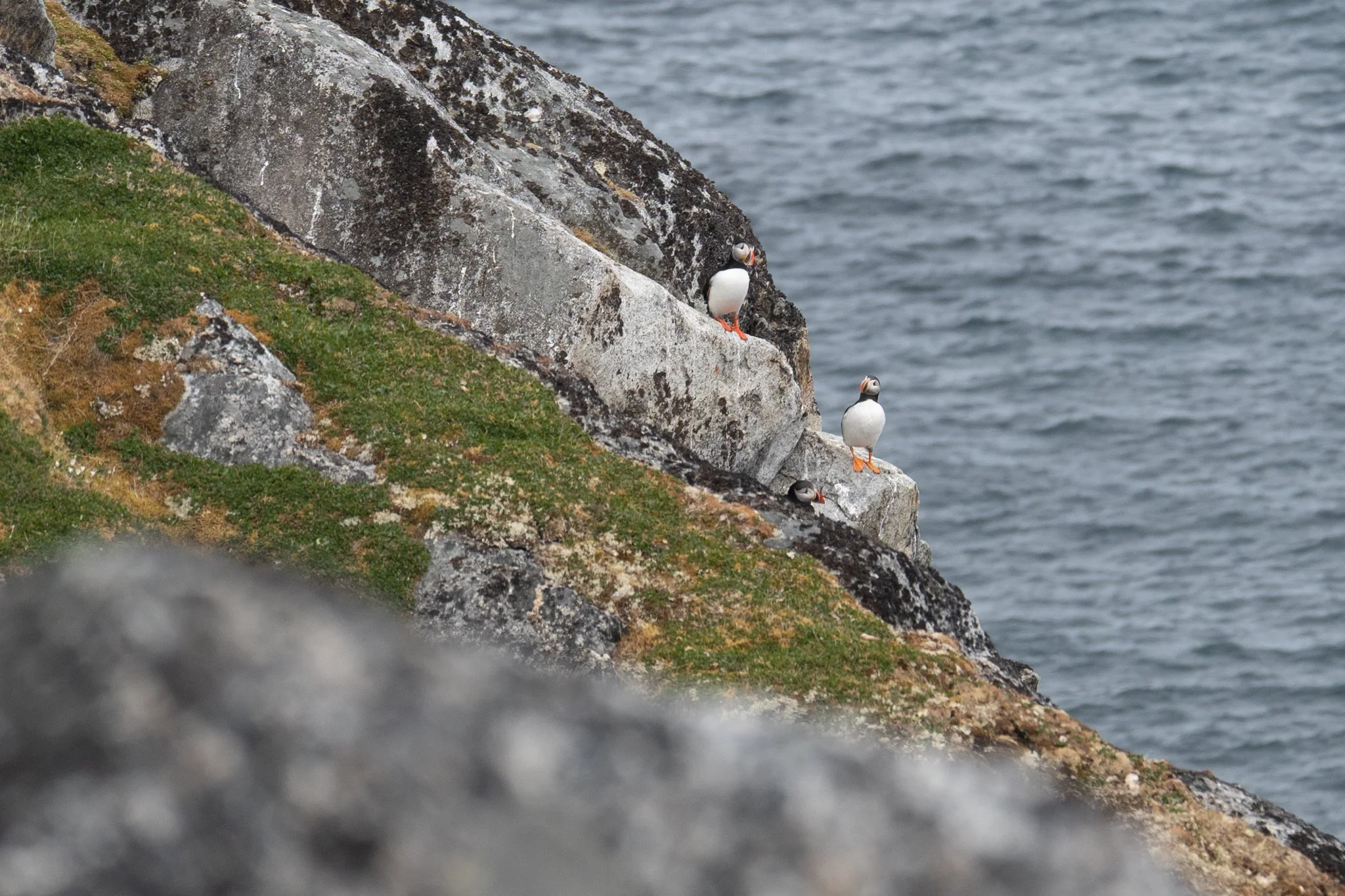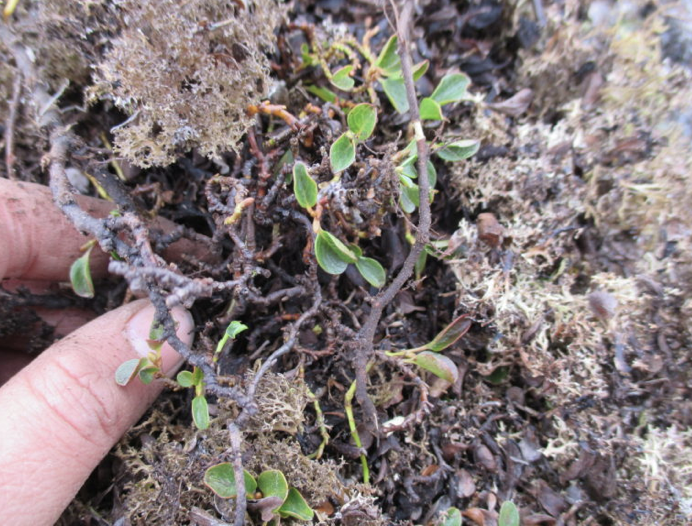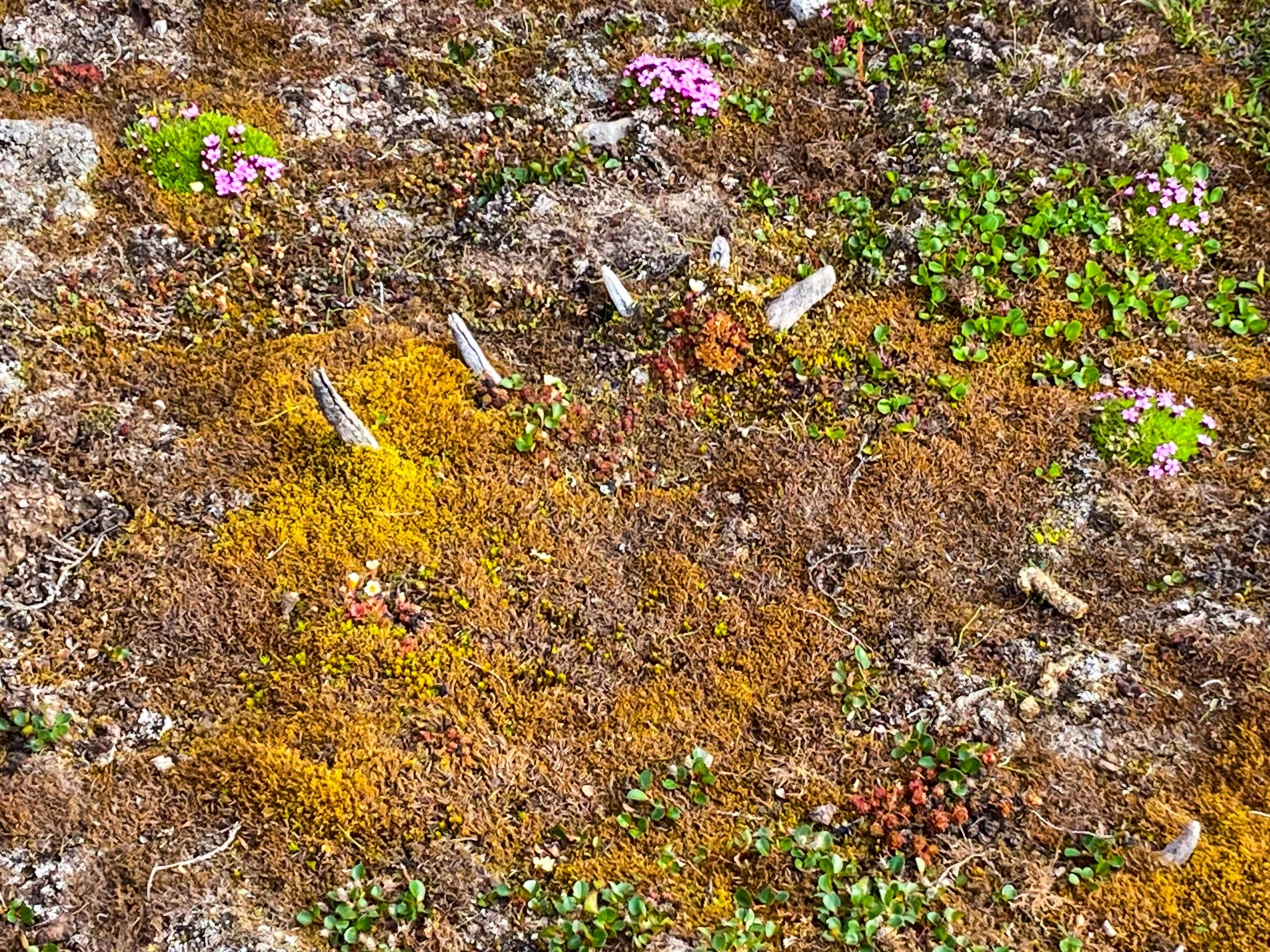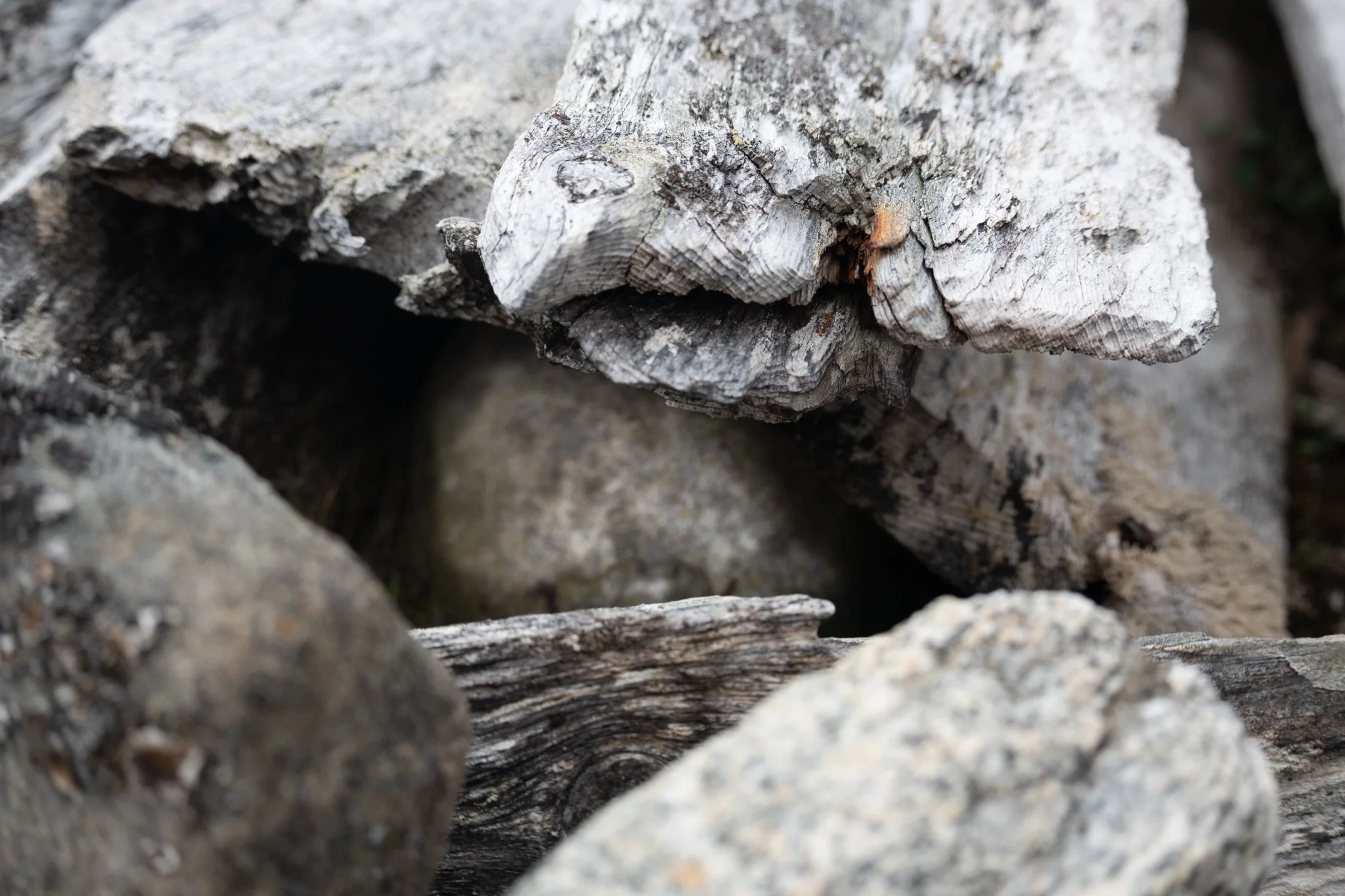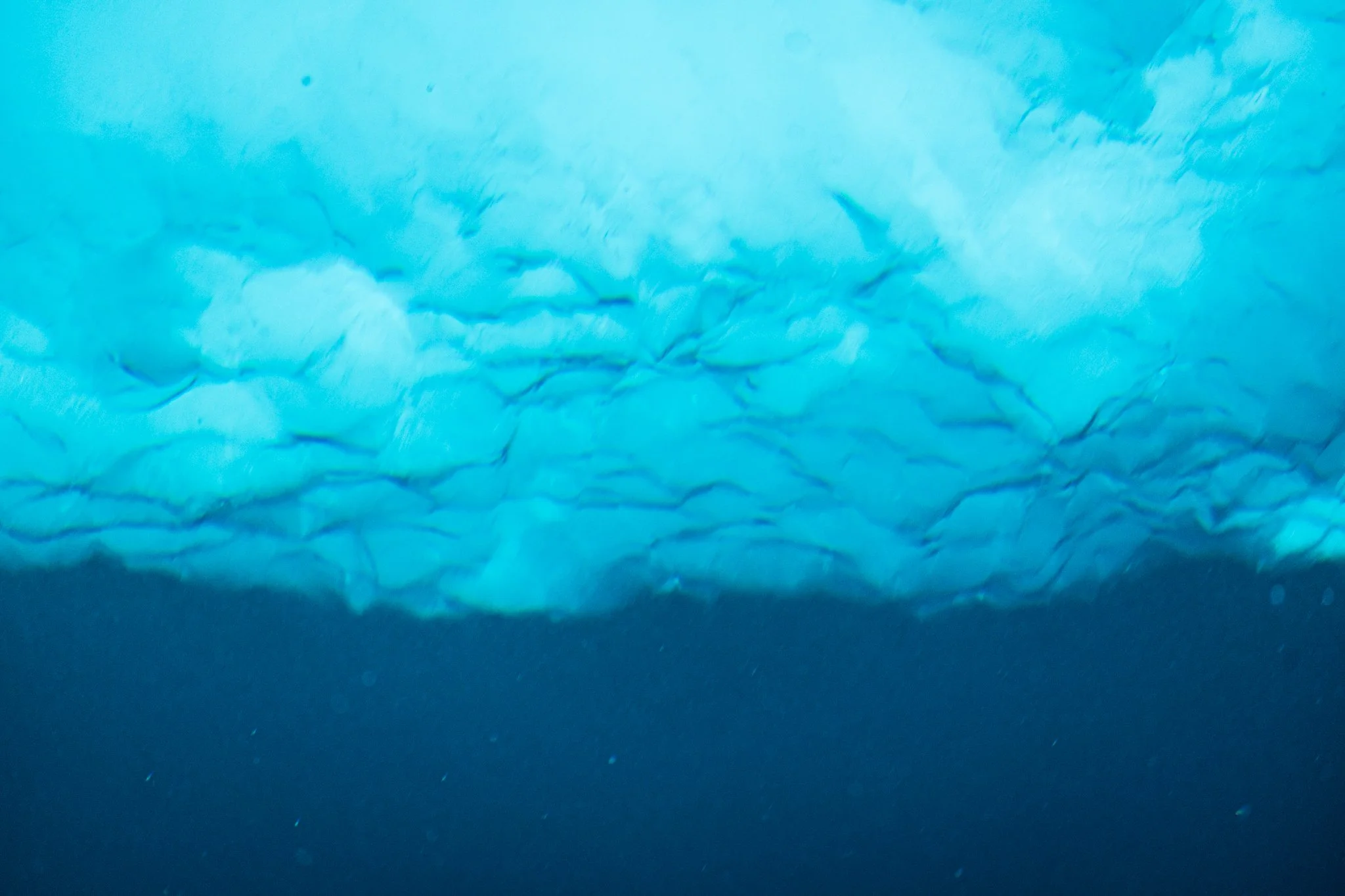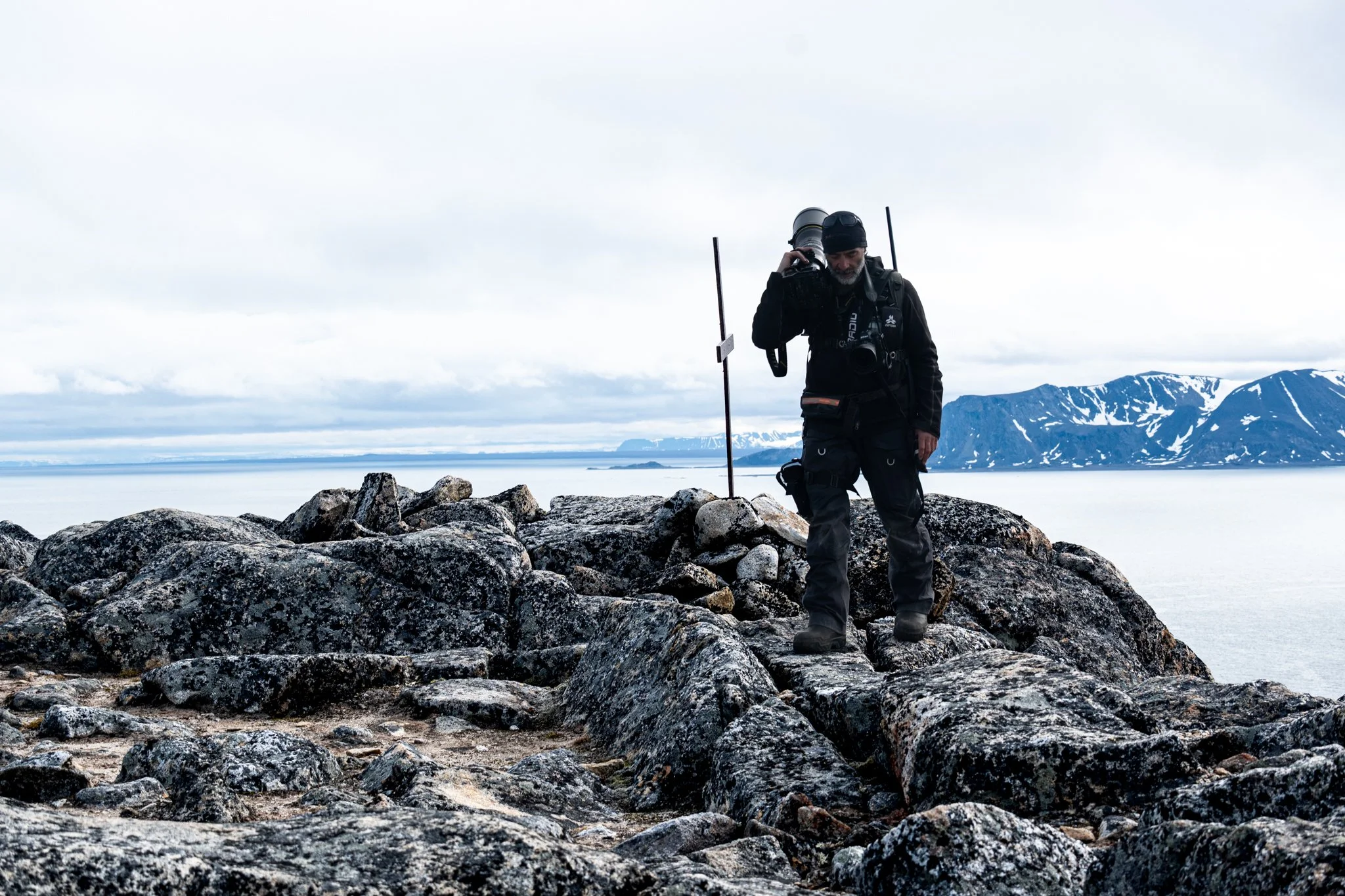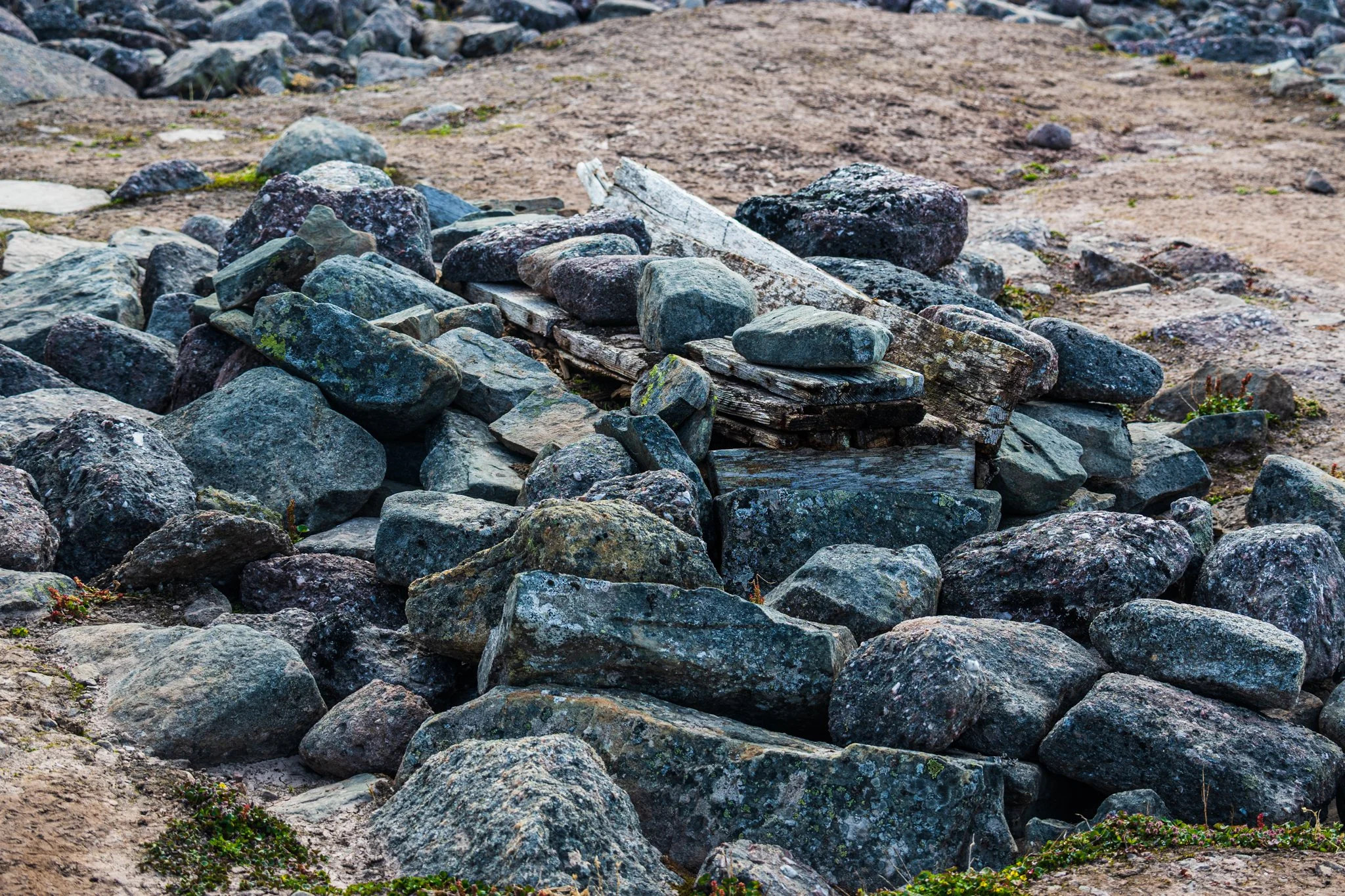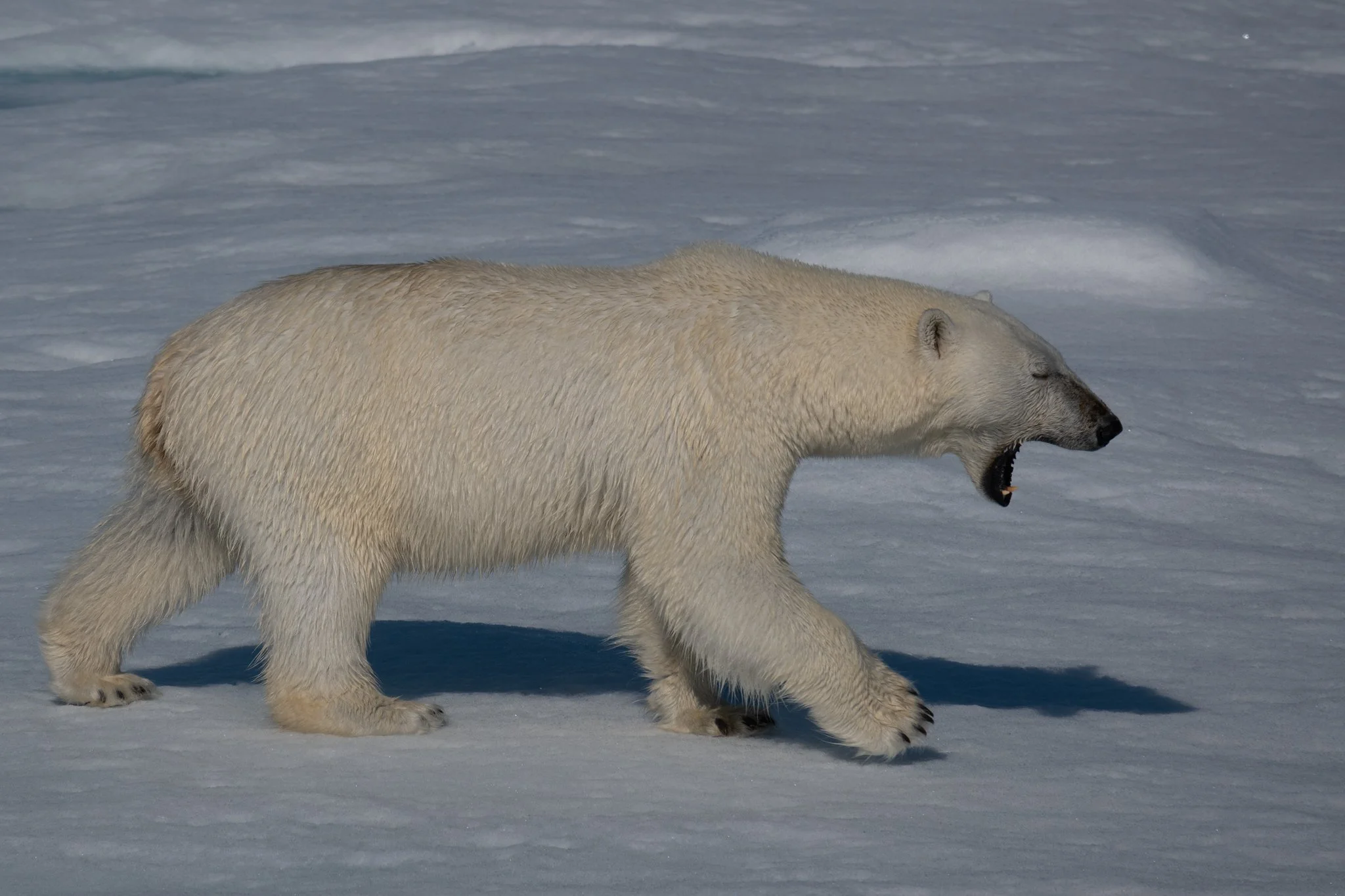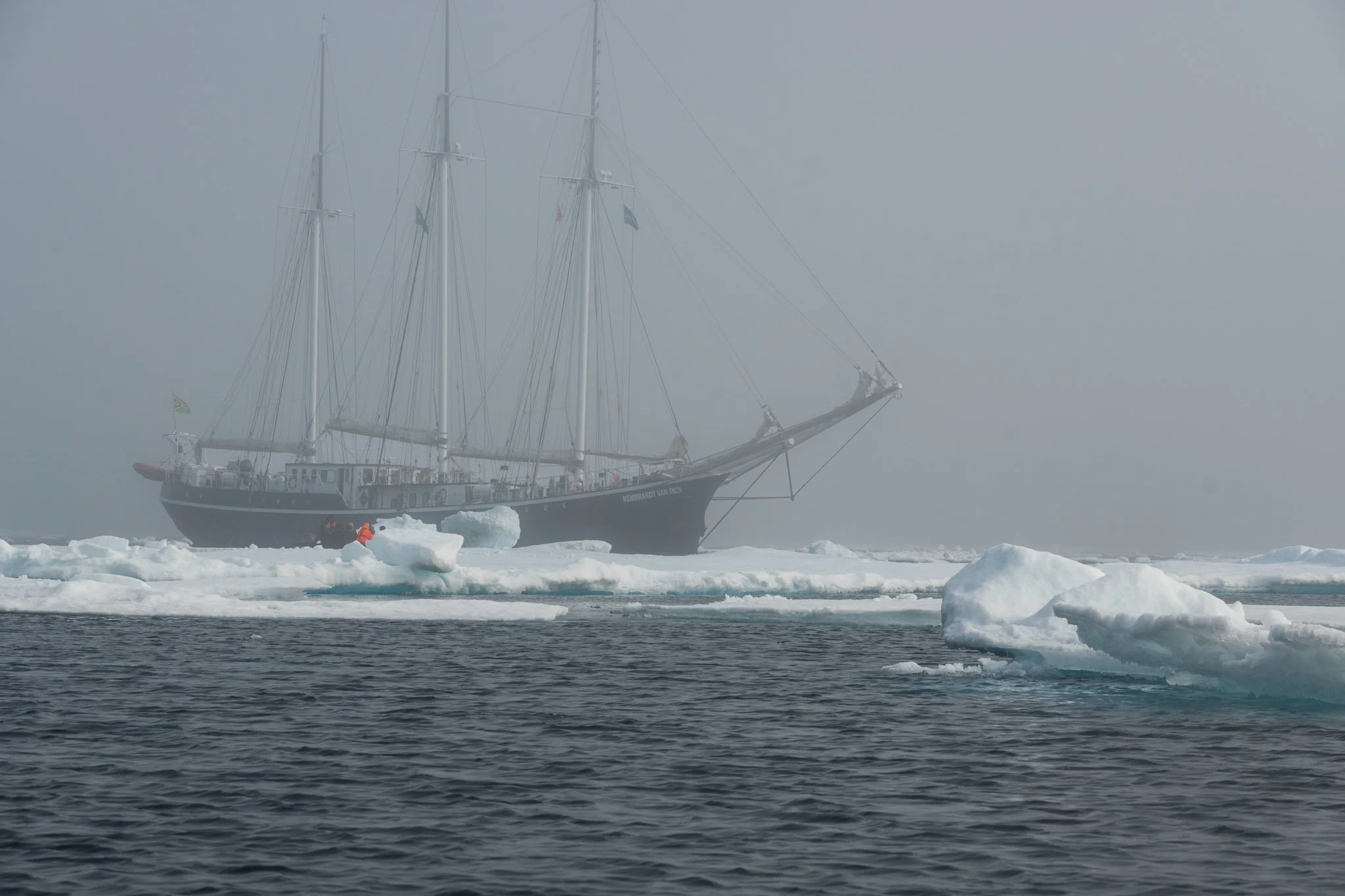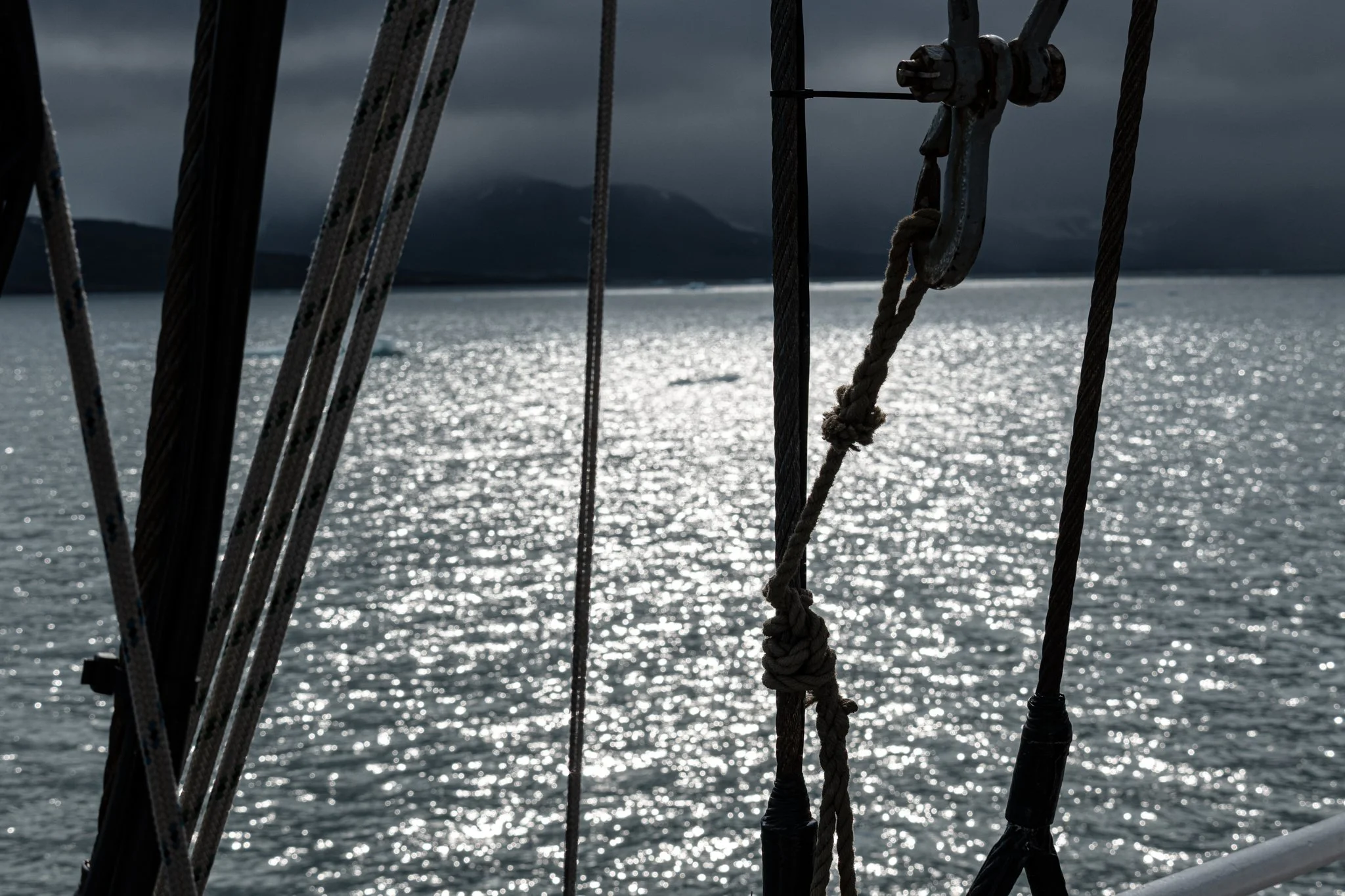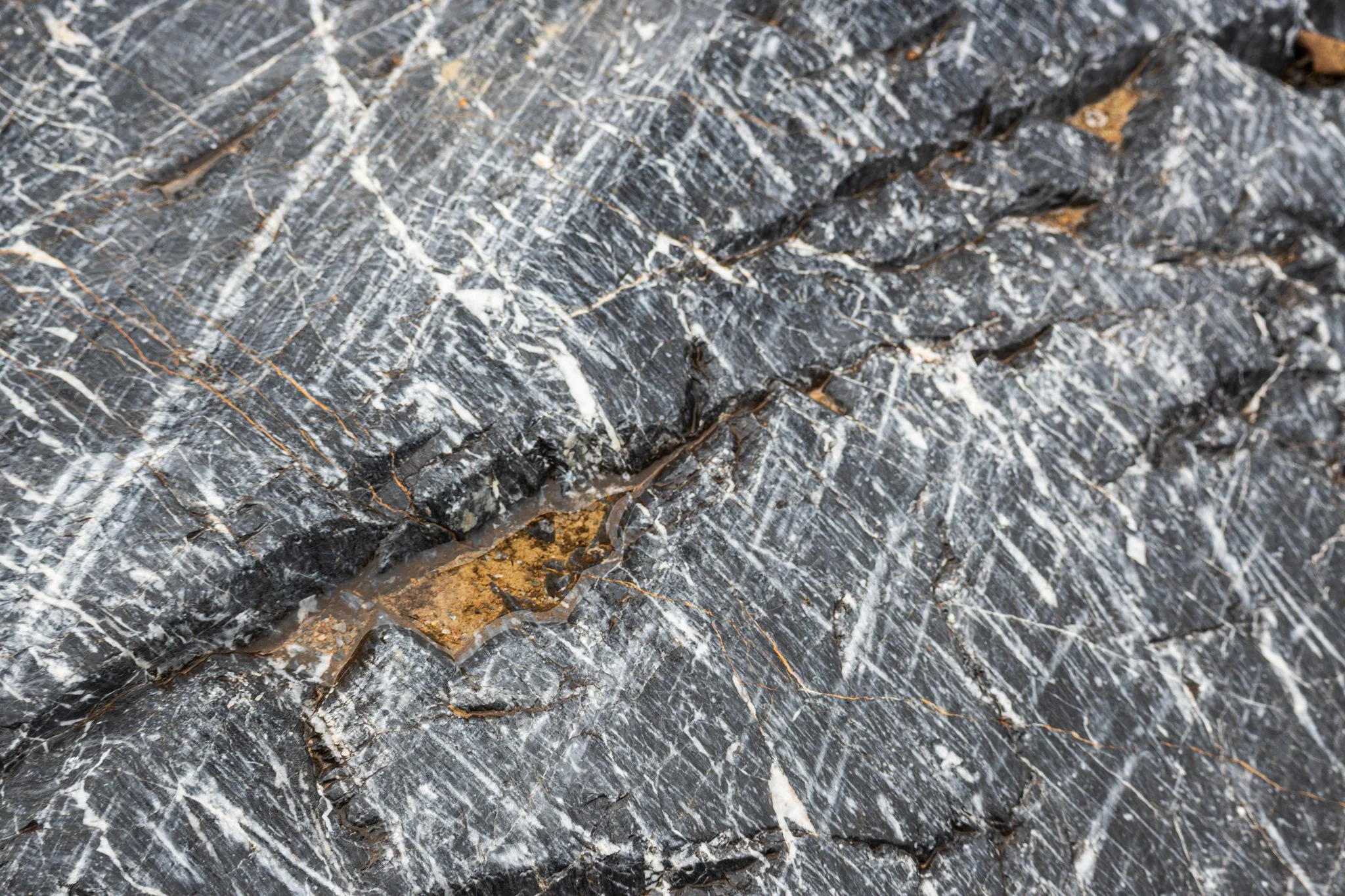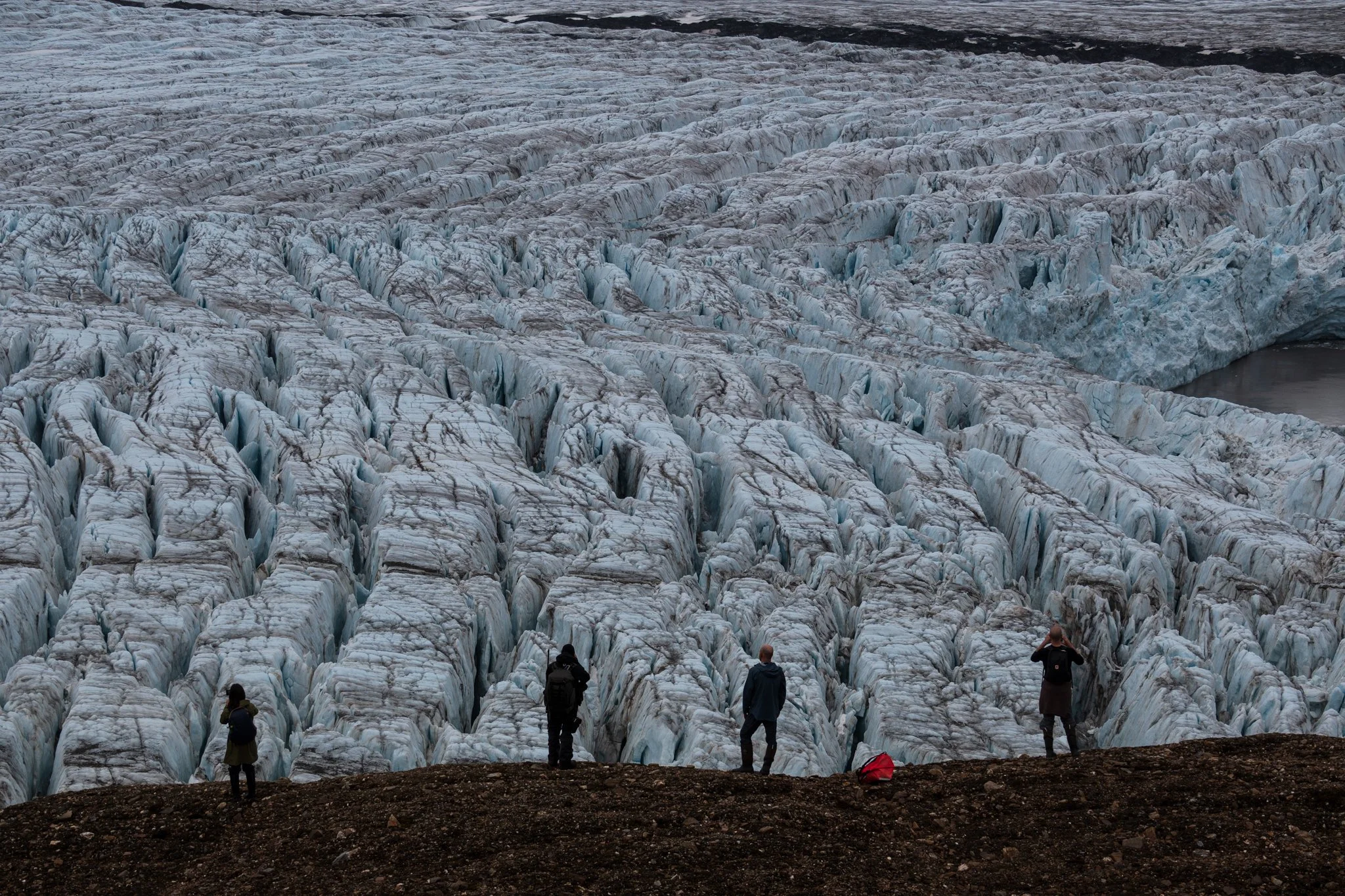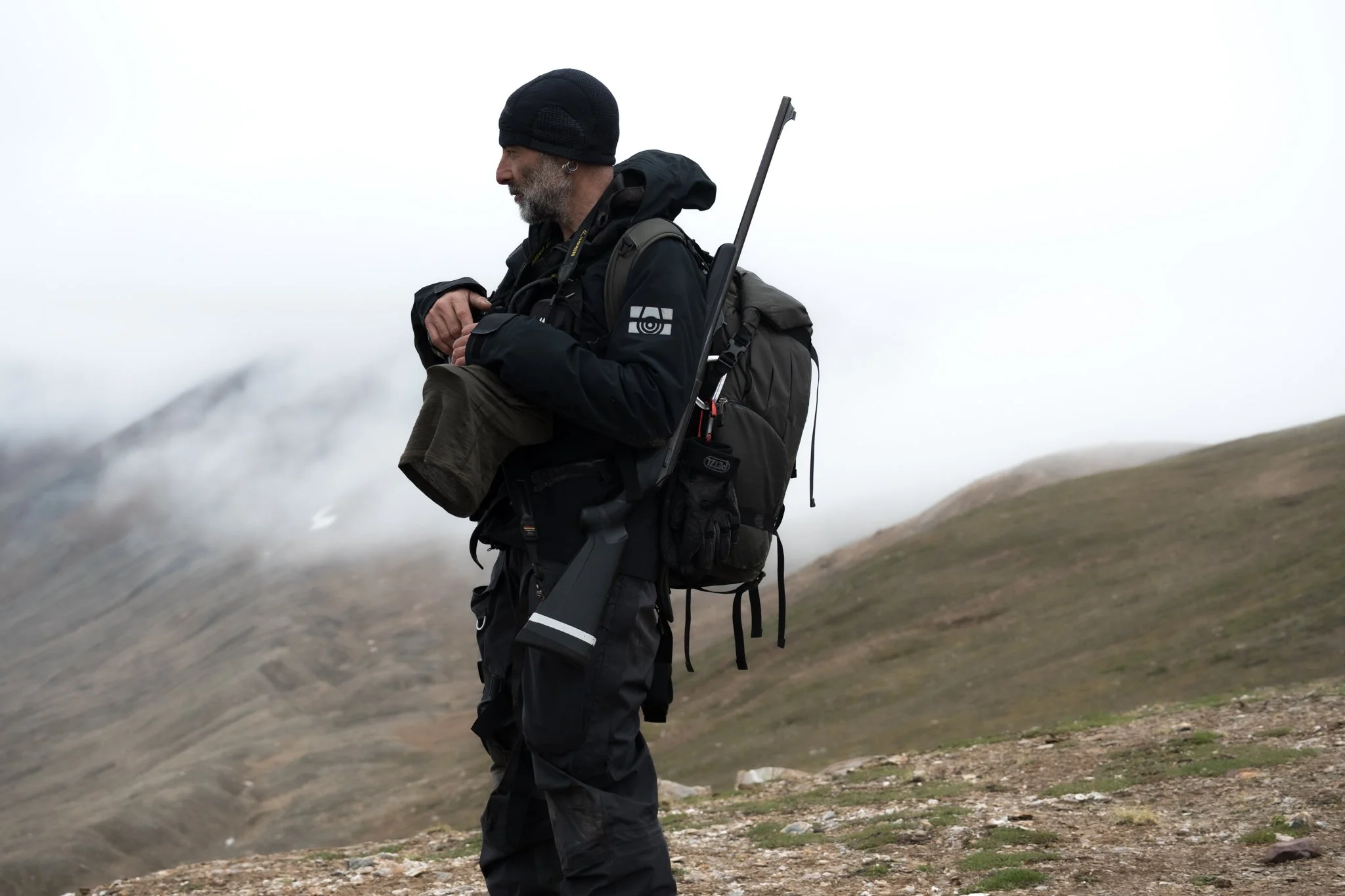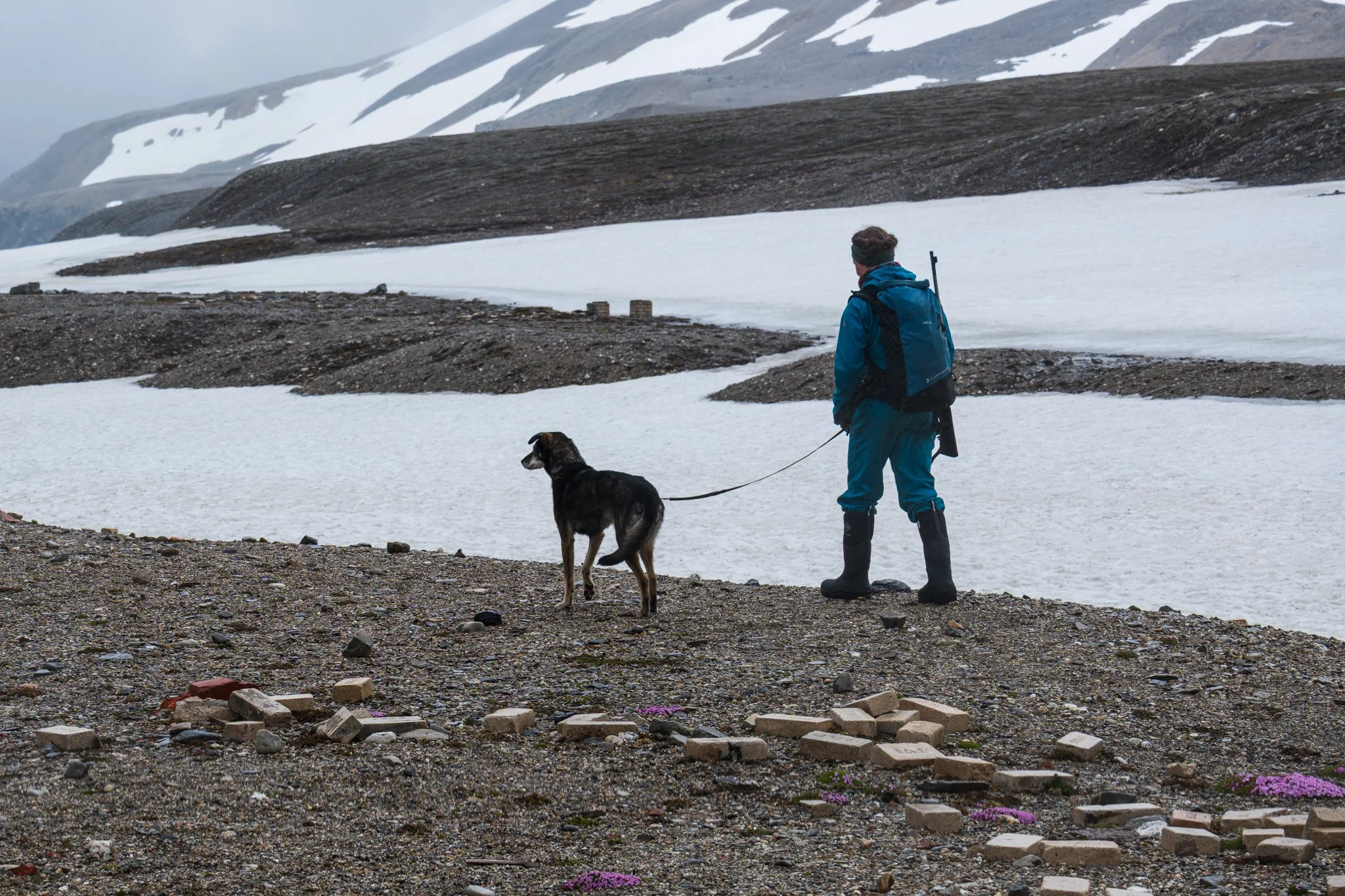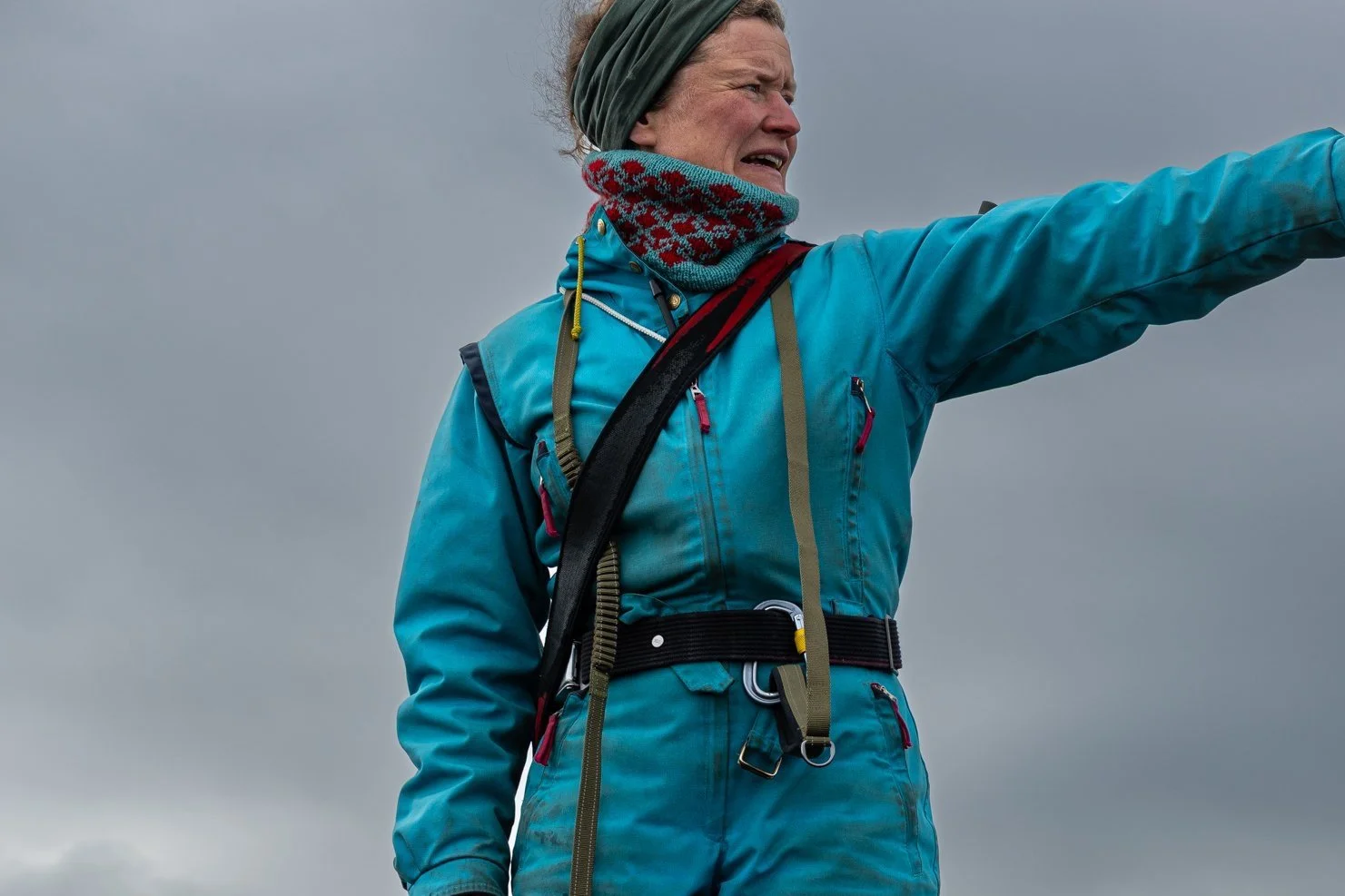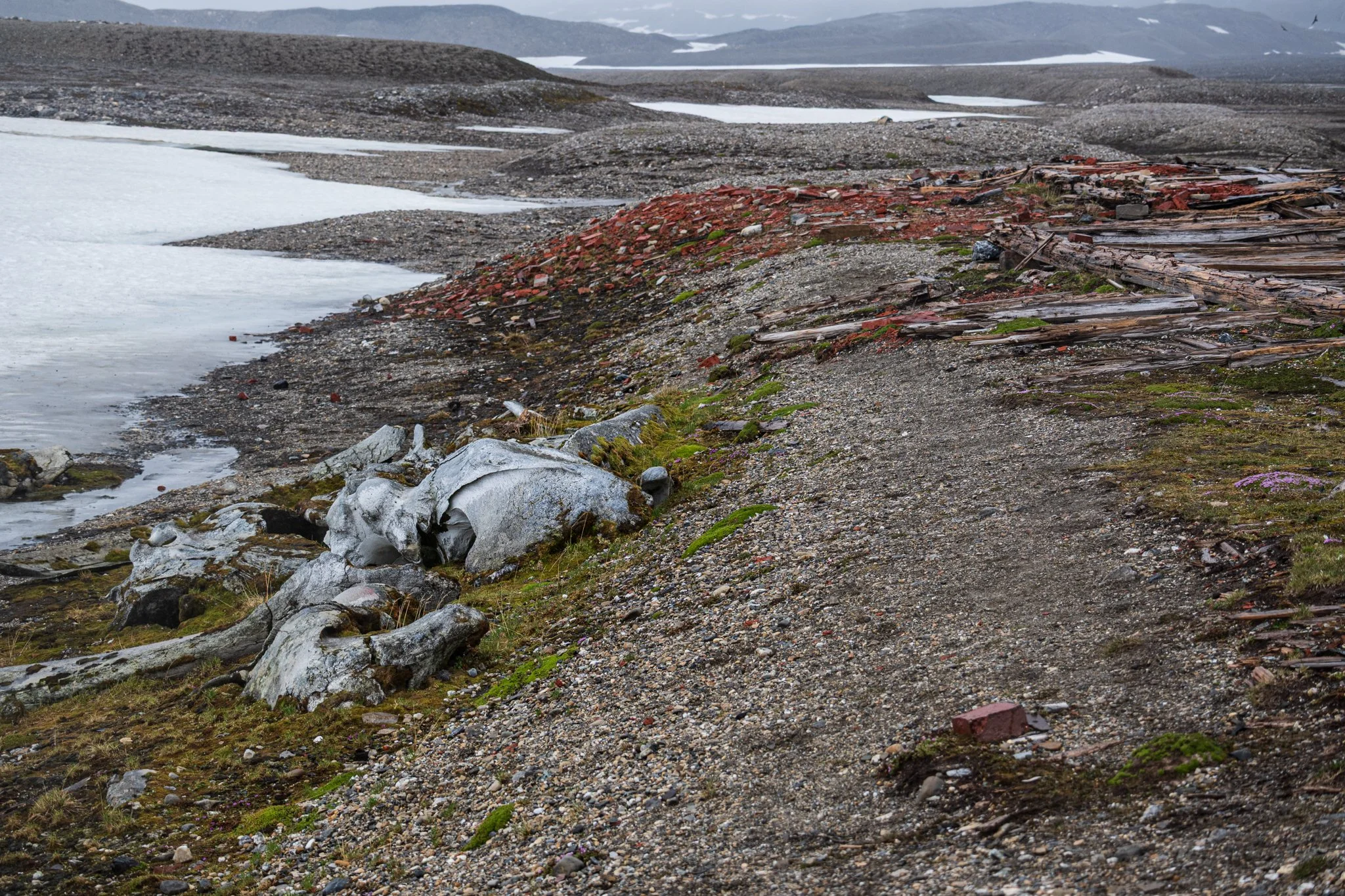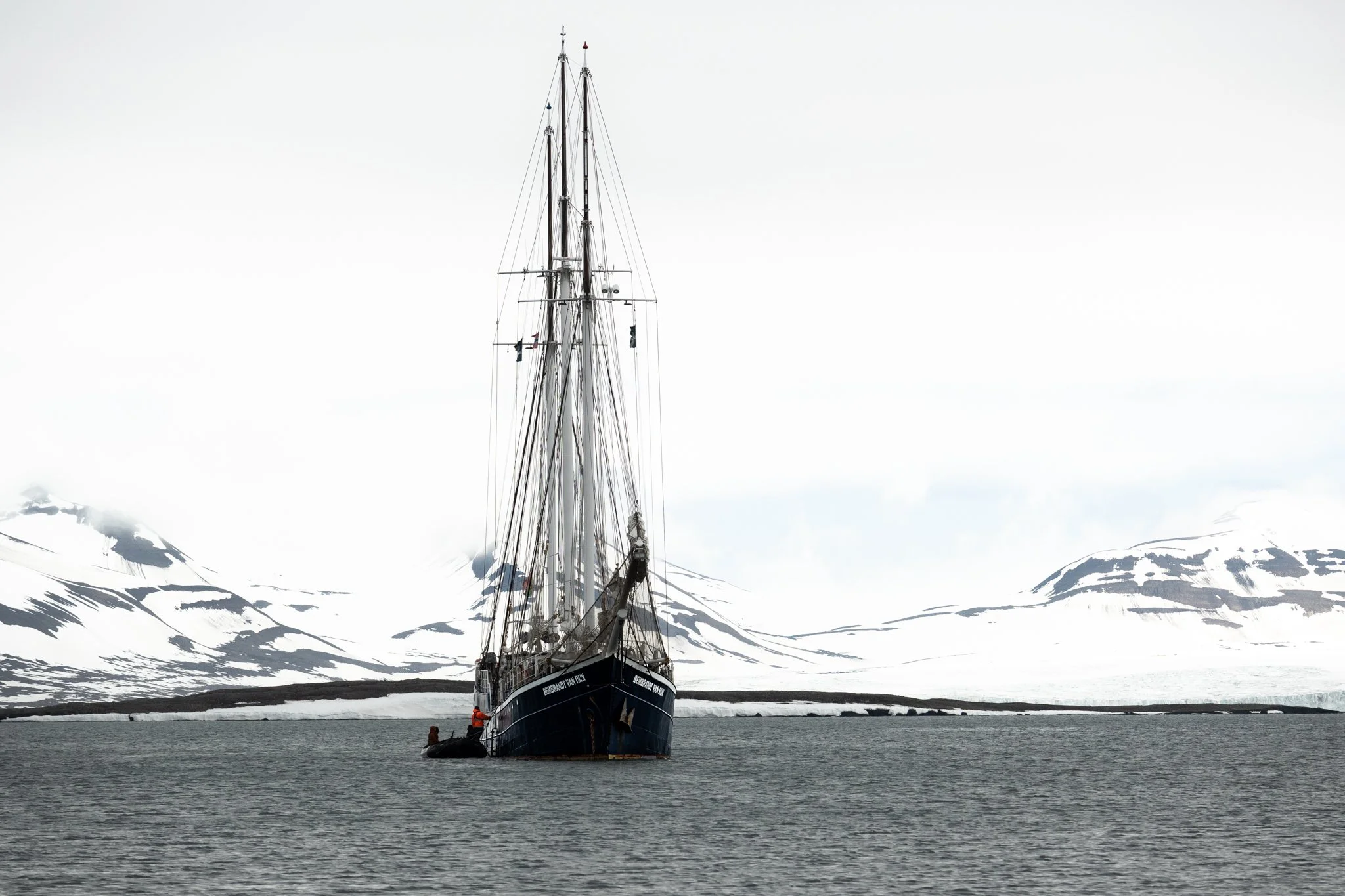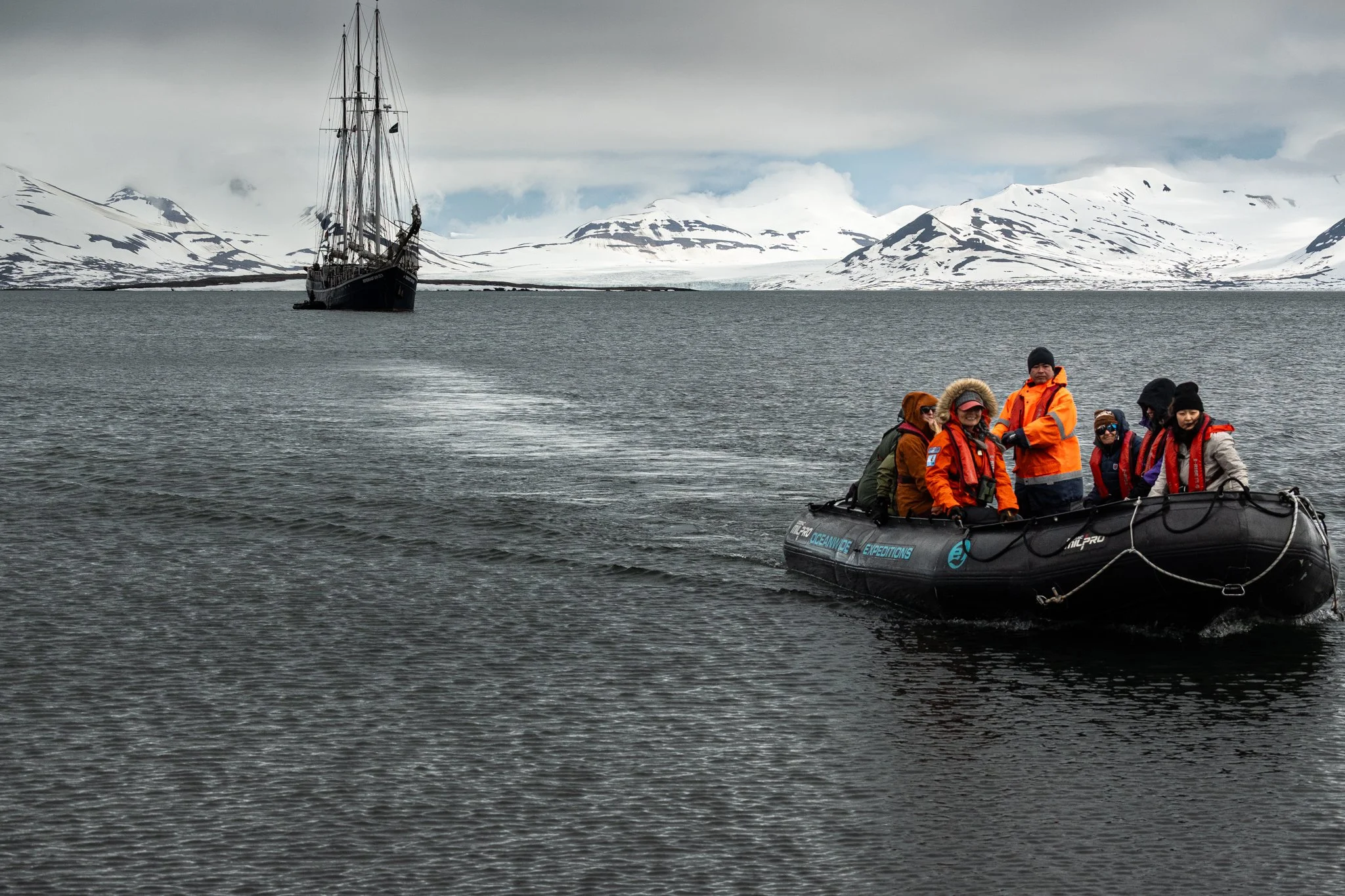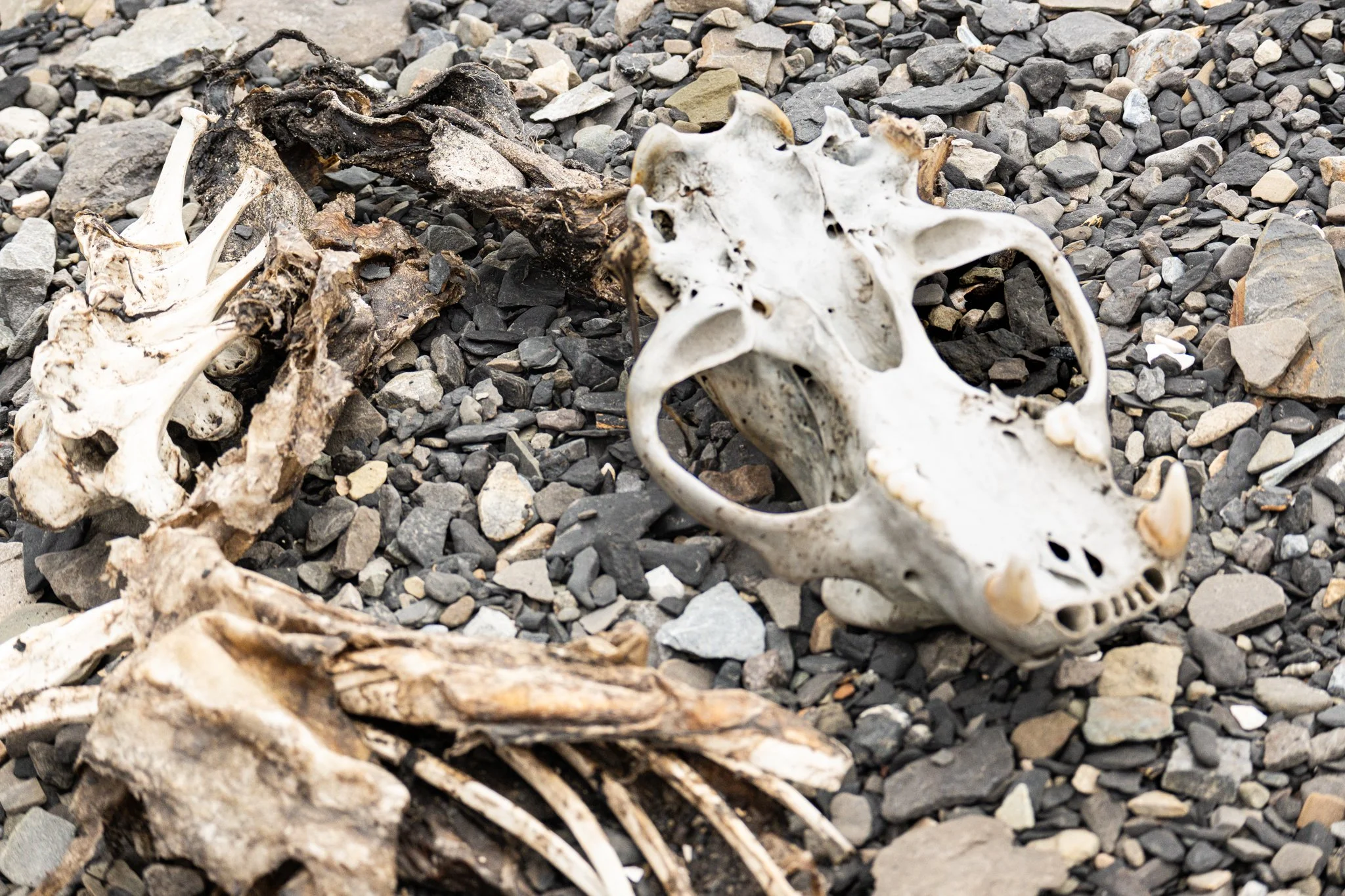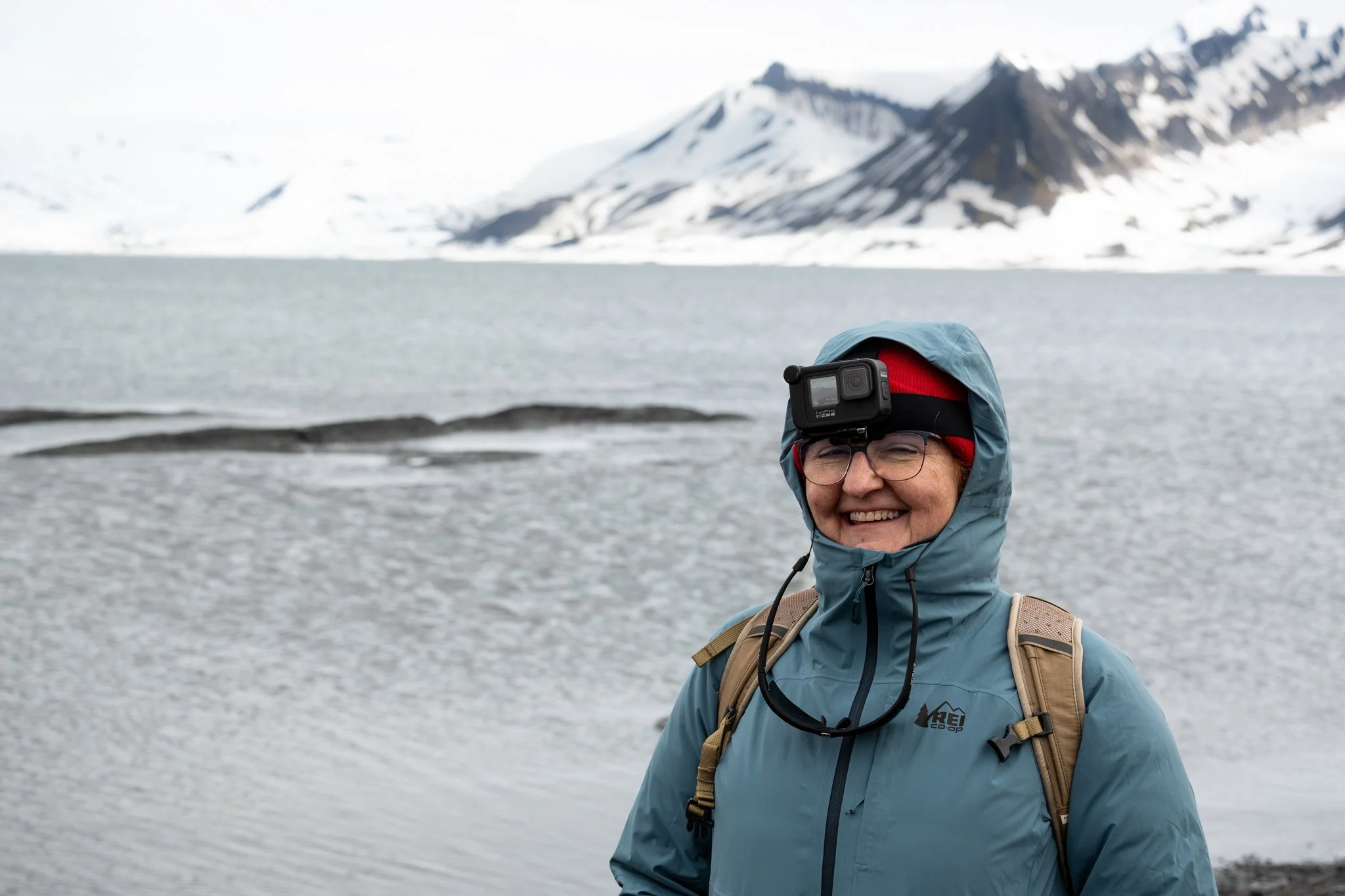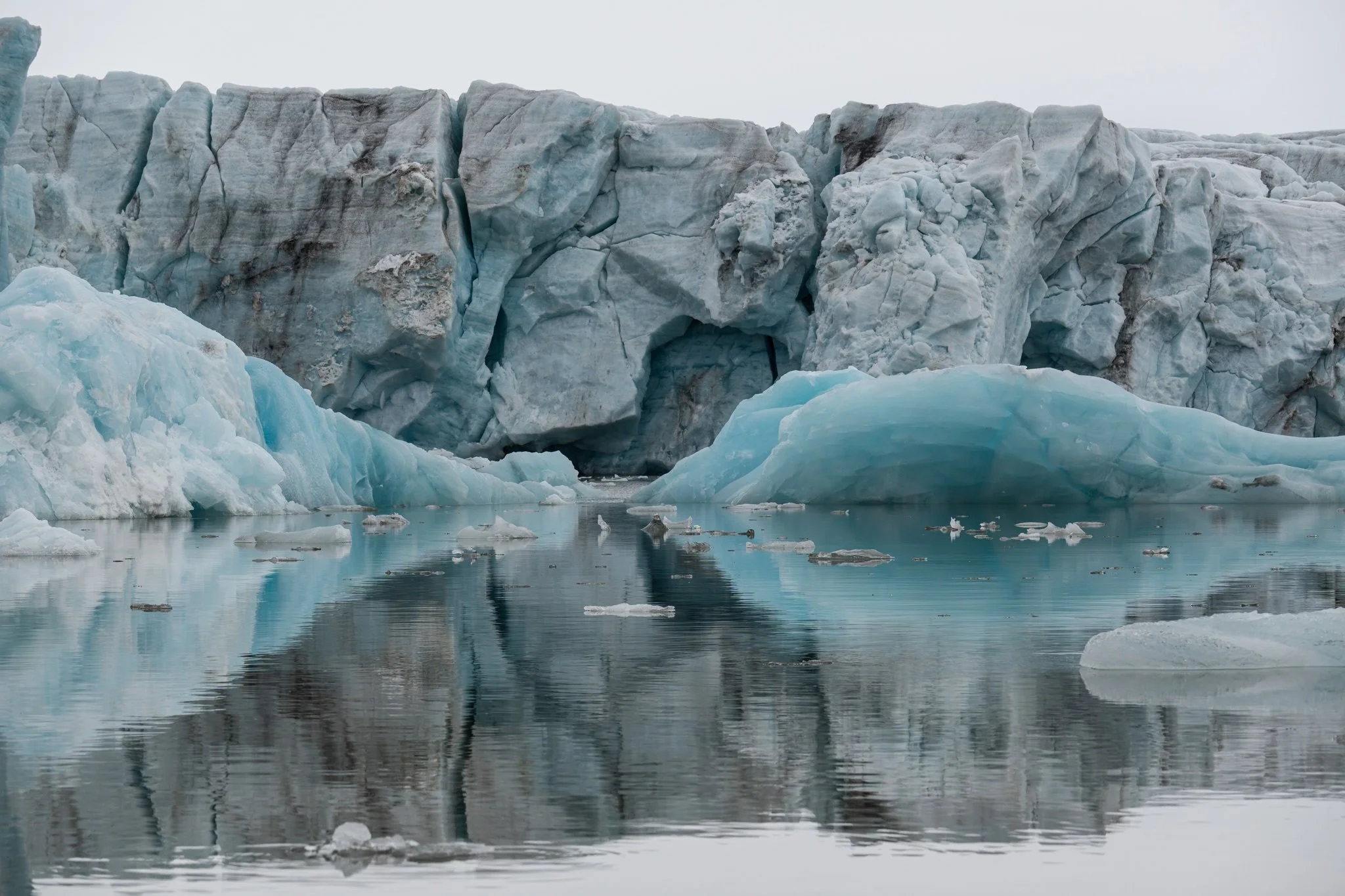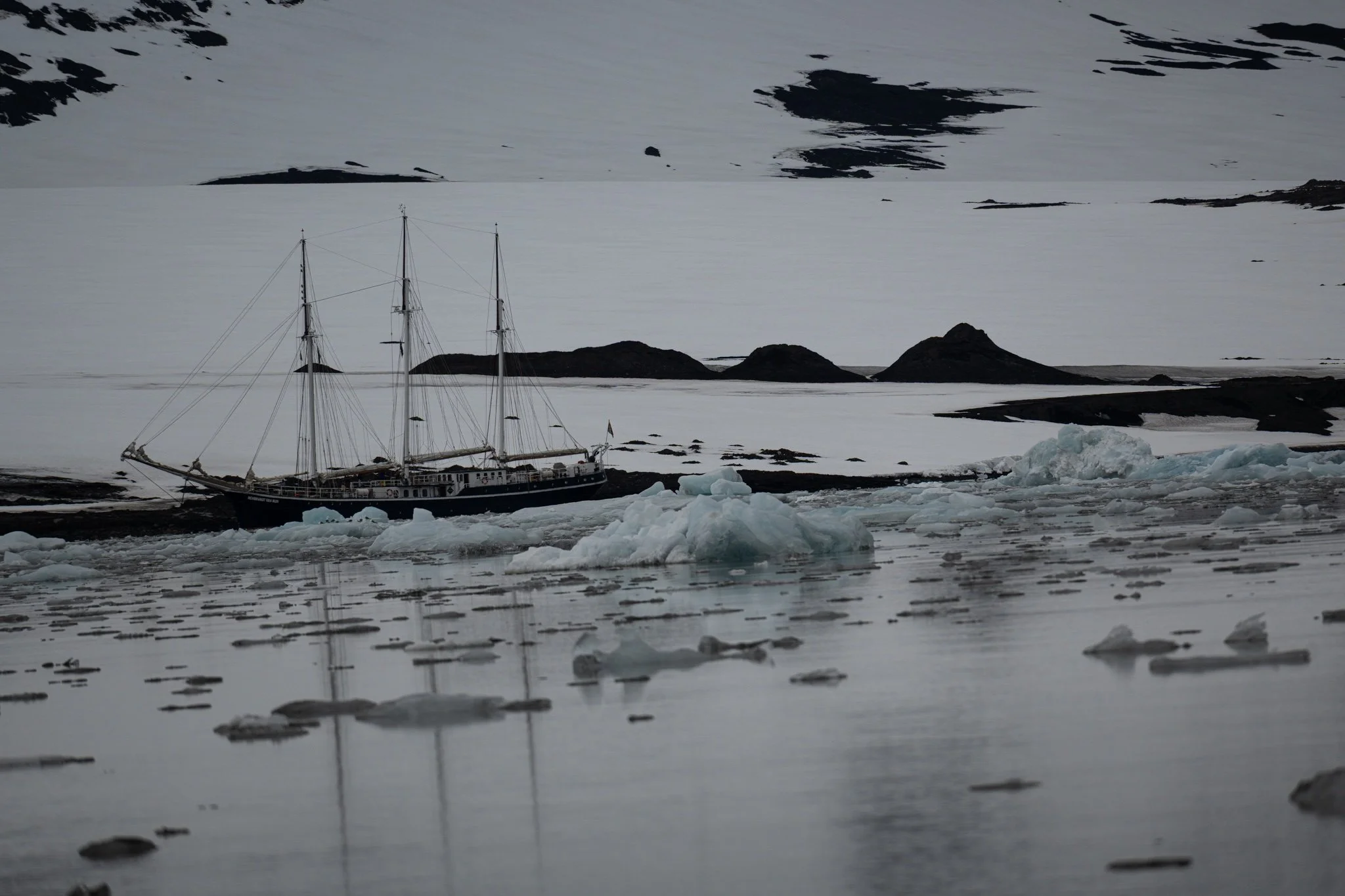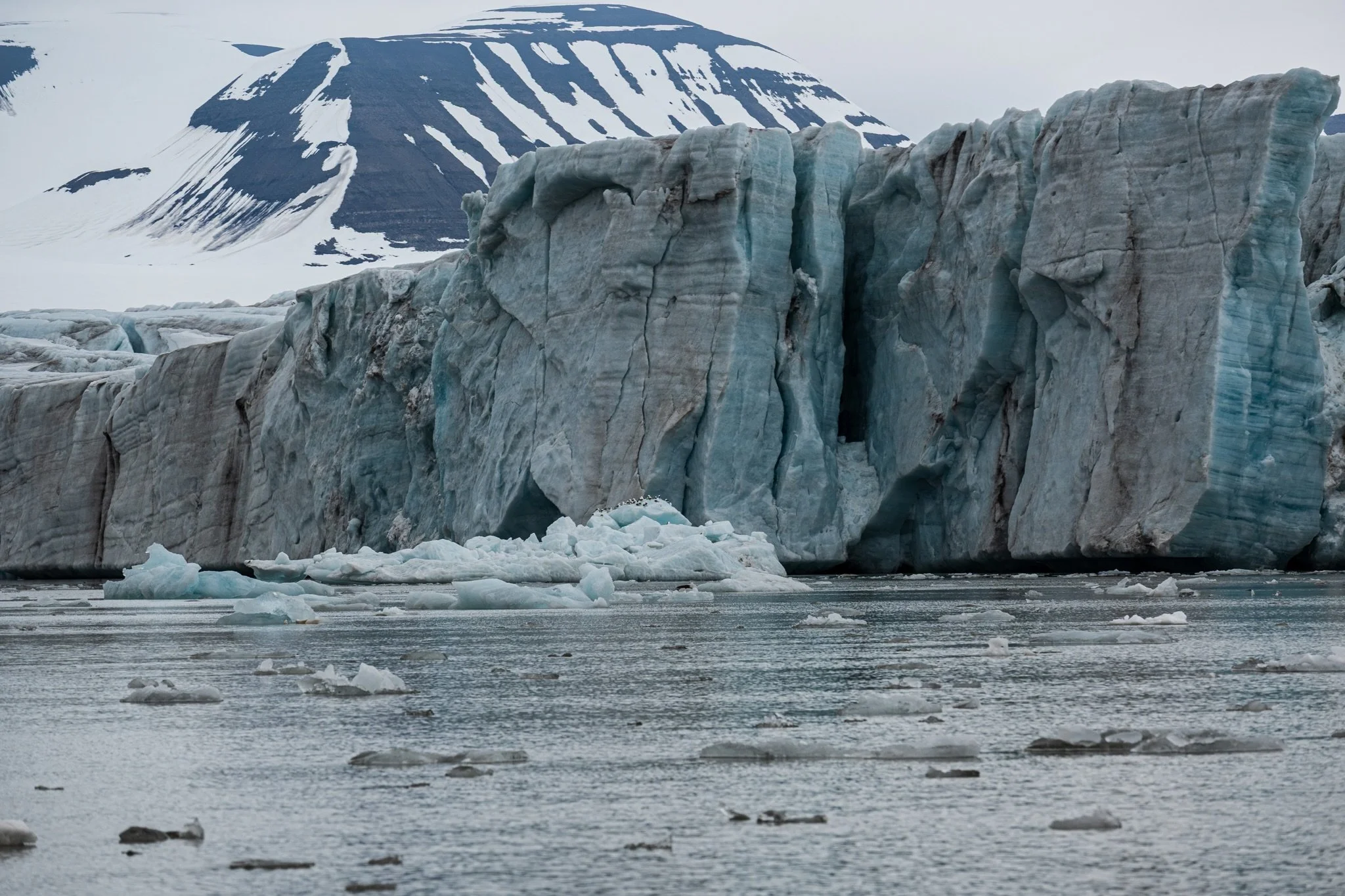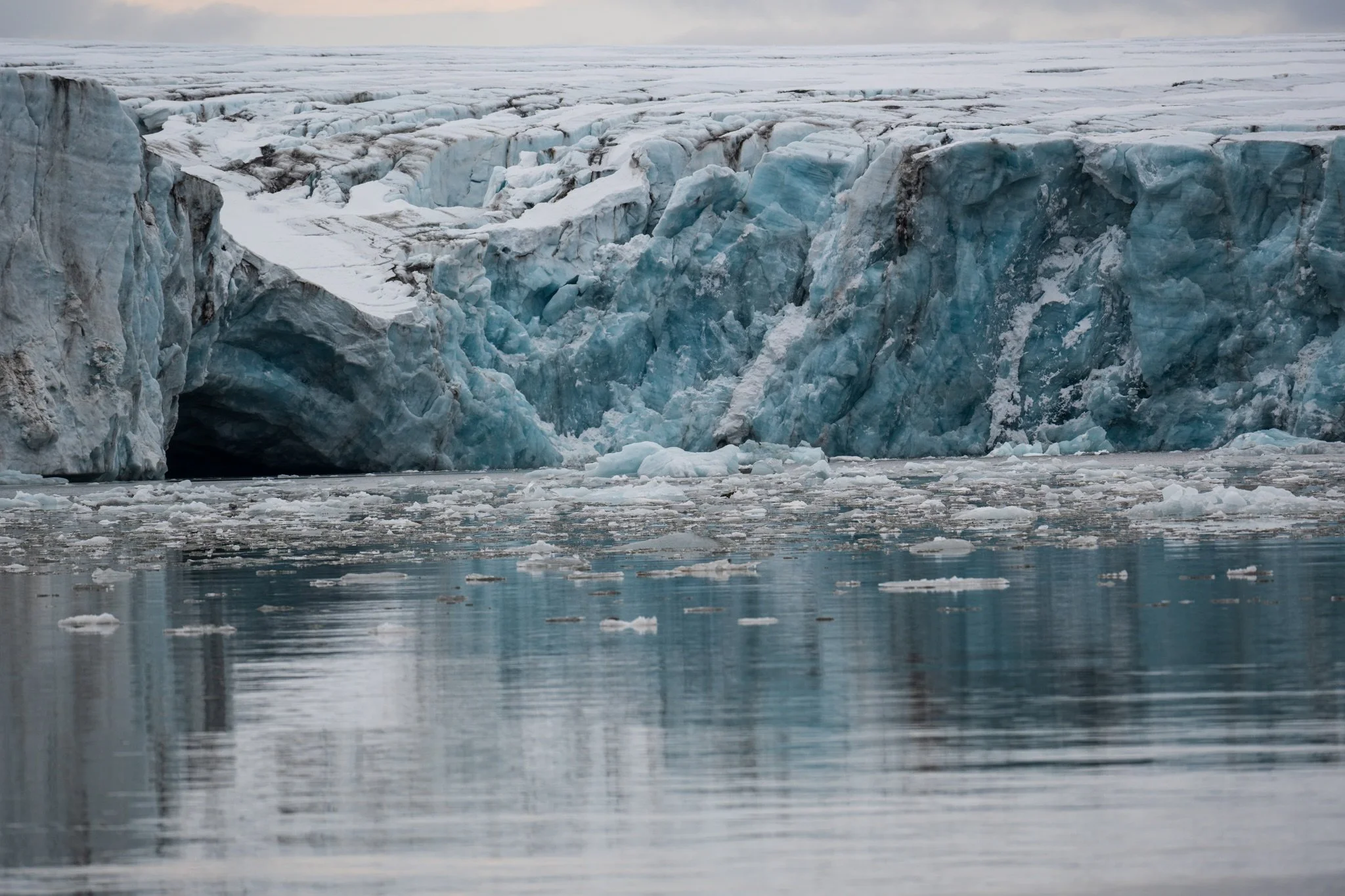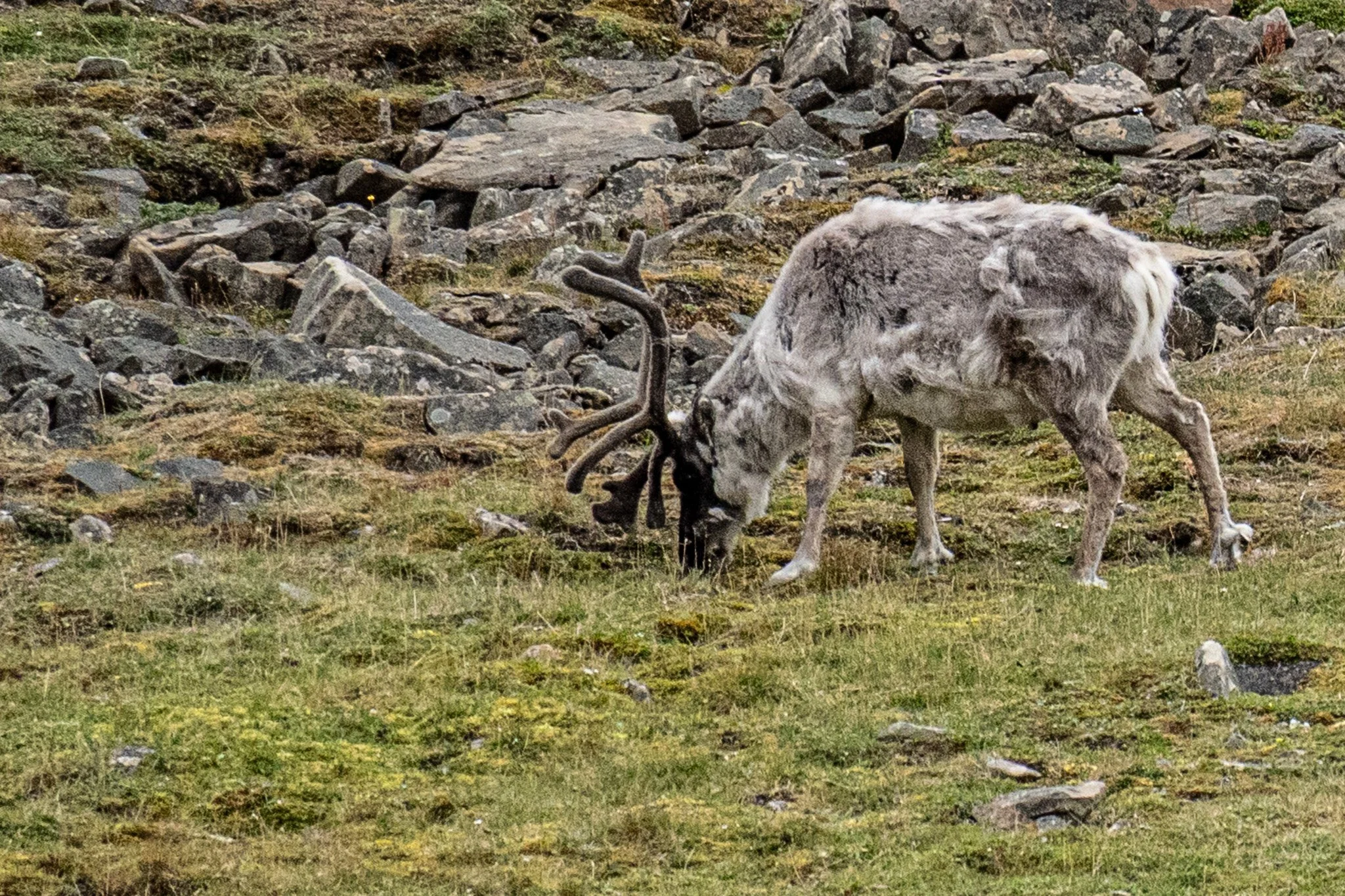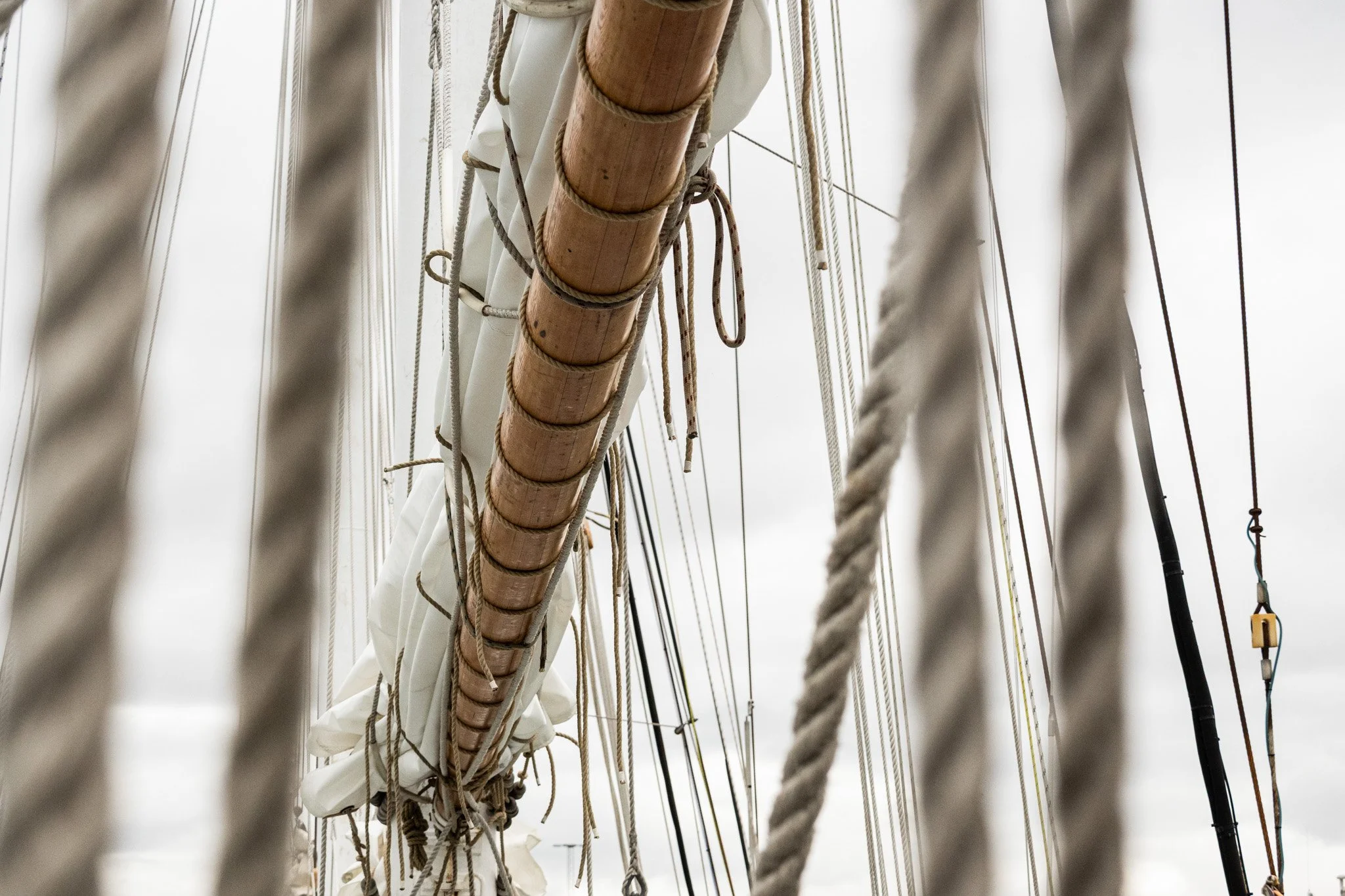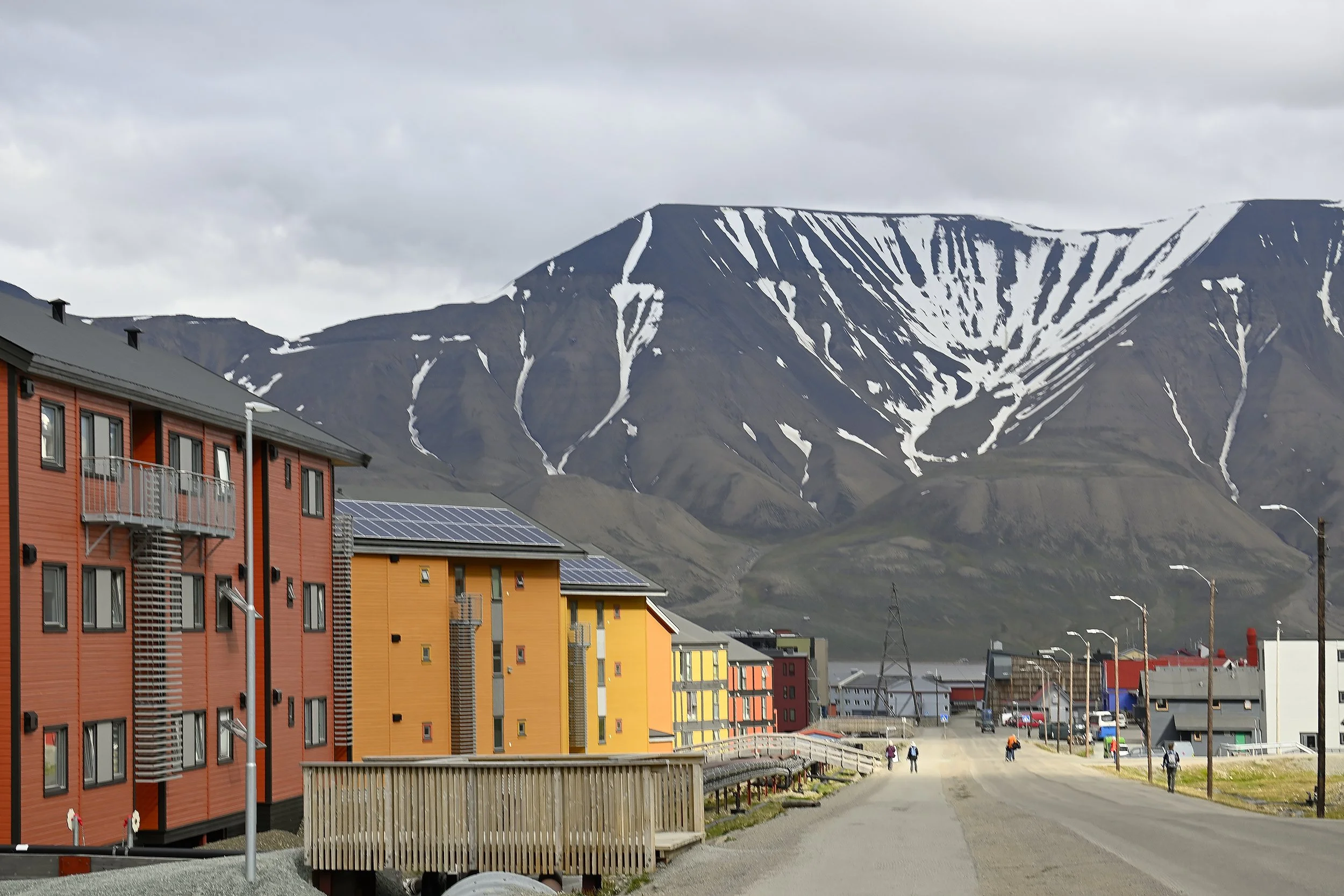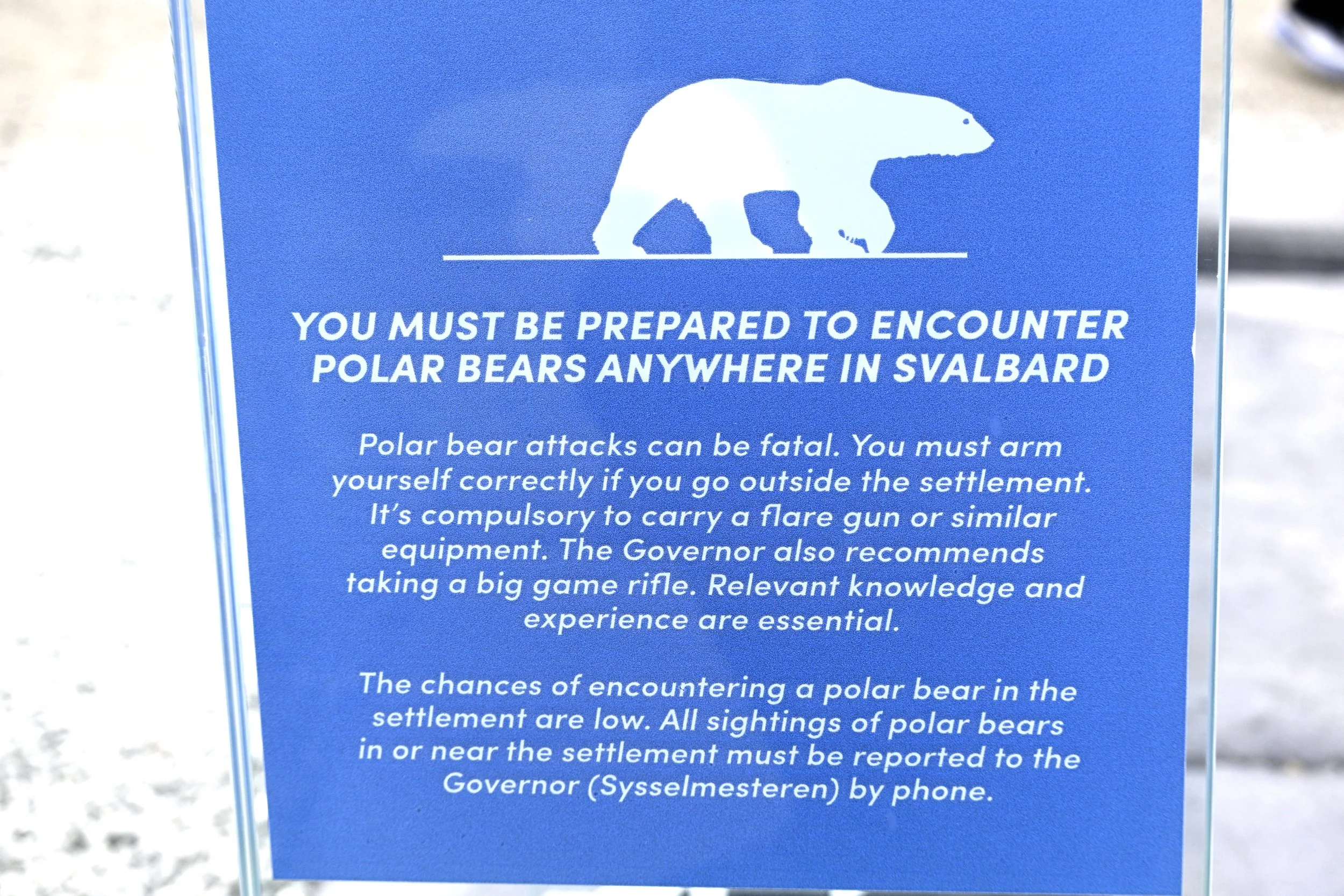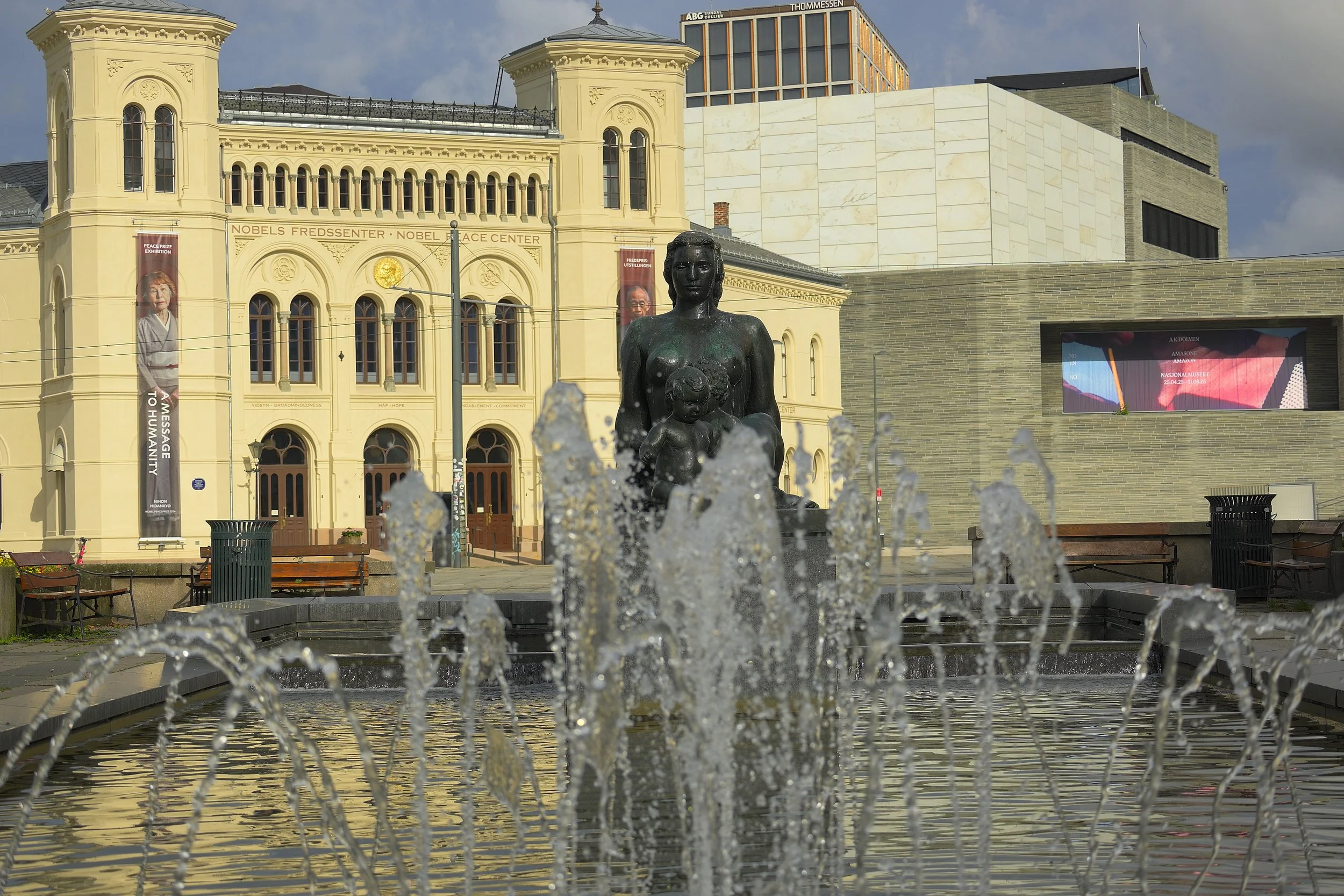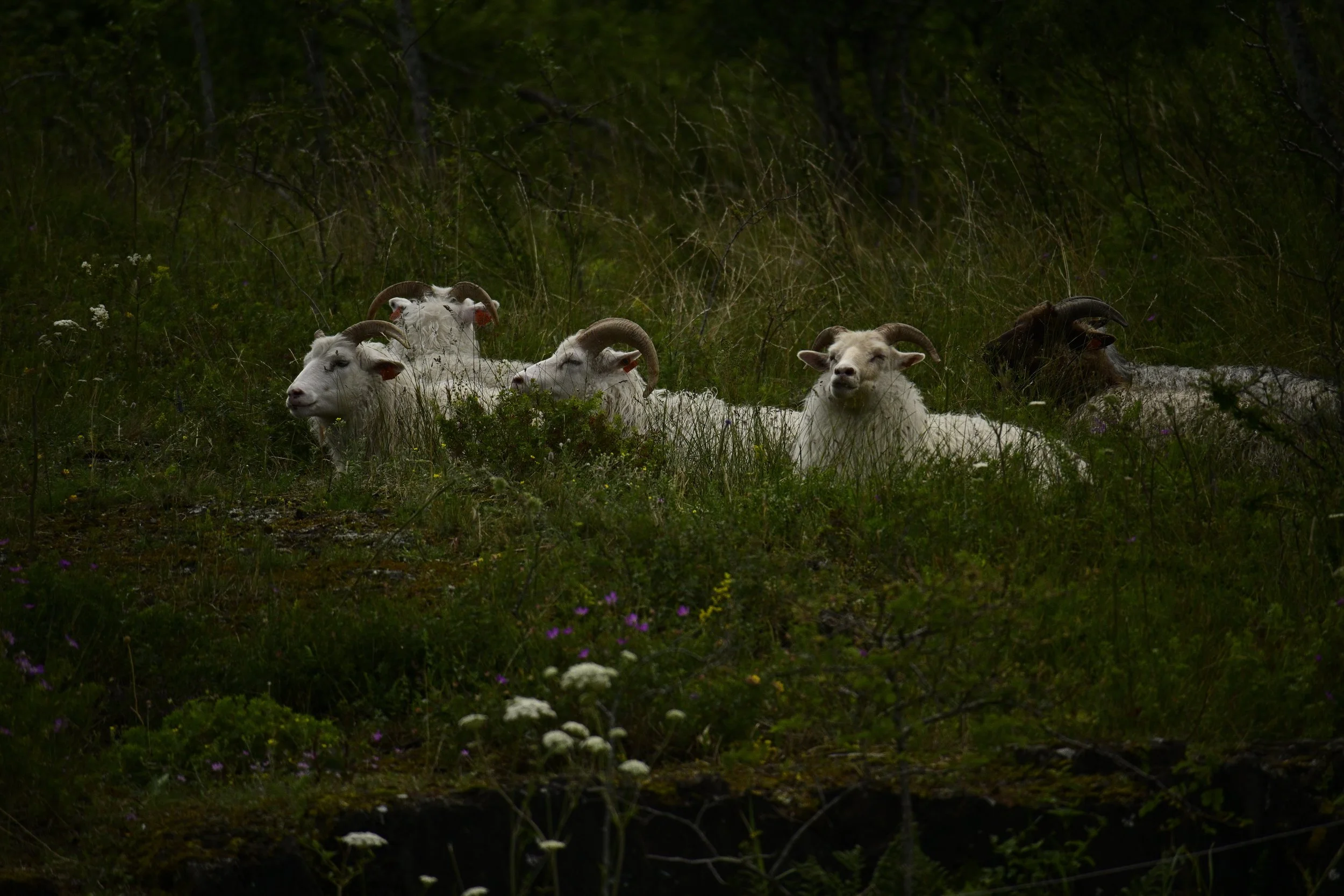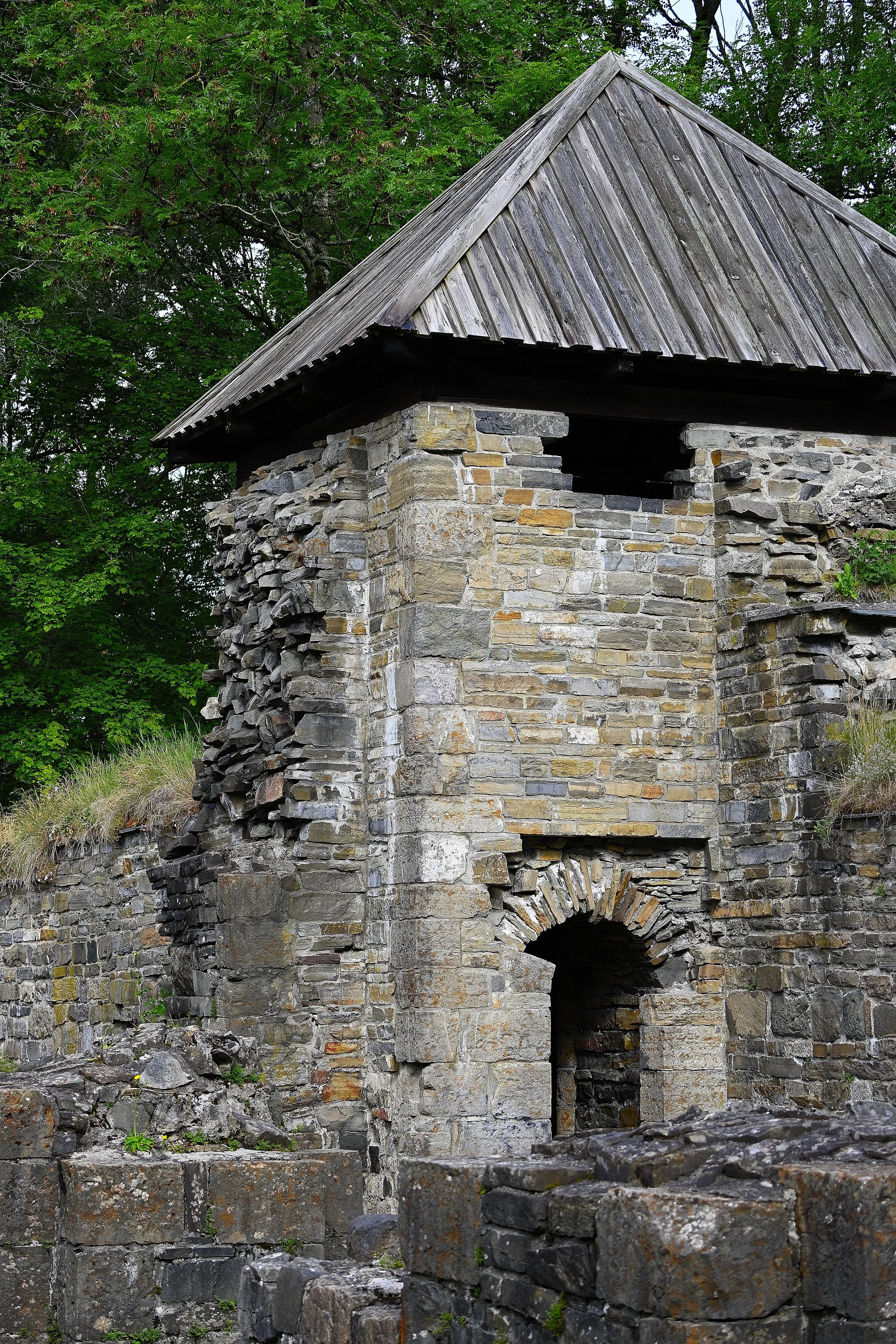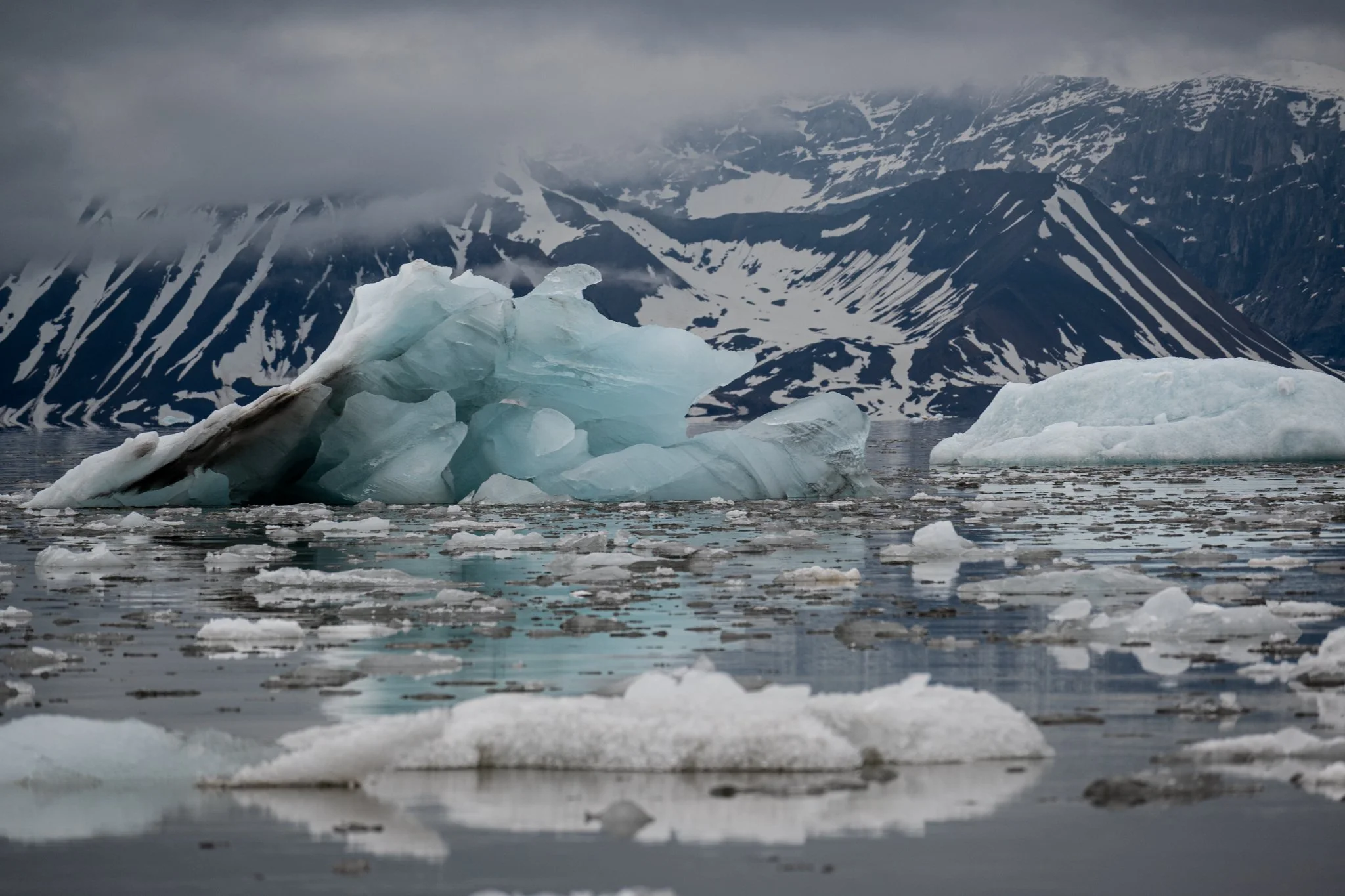ARCTIC CIRCLE RESIDENCY - svalbard July 2025
arctic circle residency - Svalbard July 2025
From July 7 - 23, I will be in the company of 33 artists of all types in a residency on the tall ship, SV Rembrandt van Rijn in Svalbard. We will explore the arctic, share ideas, hopefully encounter wildlife, and work on our own art. The main focus of the residency is to explore ways that artists can enhance climate awareness in our communities, and help to find ways to inspire involvement and interest. We artists hope to turn facts into feelings, and feelings into engagement.
I hope this blog is fun and engaging, and I welcome your input anytime! We’ll have limited wifi while onboard the ship, so it might take me a minute to respond, but I will!
Our boat - the SV Rembrandt van Rijn
July 24 – closing thoughts
Hi all! I just arrived back in Seattle, and am thrilled to experience dark nights, beautiful greenery, my own bed, and alone time. Having a moment to think back, I had a few short thoughts I thought might be worth sharing:
Highlights of the trip: standing on ice on the polar ice cap at 80 degrees N; seeing polar bears and walruses up close in the wild; hearing the expertise of our guides every day; seeing the creative and varied work of the other artists on the trip; creating an impromptu choir that sang to a little iceberg that we brought on board.
Challenges: tight quarters and no time to be alone; difficult to get exercise; some seasickness on the choppy southern cape
Takeaways: the High Arctic is gorgeous and severe; it’s very difficult to go there without compromising a sensitive environment even further; artists really are an open-minded, resourceful, generous group of people; the crew and guides are incredible people.
I had to share one more photo of puffins, because it took me until today to realize that there are 3 in the photo!
This is the tallest tree in Svalbard - the polar willow. It can reach the soaring height of 3cm. Everywhere we walked on land, we had to be extremely careful of the vegetation, because it is such a tough place for things to grow.
In Longyearbyen, the tourists can buy as much alcohol as they like. The residents, on the other hand, have a strict limit of 24 beers per month. This is reportedly a vestige of the coal mining days - the miners preferred beer, so their consumption was limited, while the owners of the mines preferred wine, and there was no limit placed. Longyearbyen is a lovely little town with colorful homes, cafes, restaurants, bars, 3 museums, a school, a non-denominational church, and a library. After our time on the boat, it felt like a boisterous metropolis.
Our boat with the Coliseum behind - getting close to Longyearbyen
July 19-22, 2025 – DAY 13 Saturday-Wednesday
My apologies for the missed days! After the shock of having wifi on the polar ice cap we didn’t have wifi for several days because of our proximity to the research station at Ny Ålesund. We had to turn off wifi and bluetooth – all phones, computers, ipads, smart watches, tracking devices, even cameras and google glasses. It was amazing how many devices each of us had that we didn’t even know used Bluetooth – it took quite awhile to track everything down (the captain could see when devices were on).
There are photos of people, too - I just need to review each person’s permission before posting. There are also photos of me, but they’re on other peoples’ cameras, so I’ll post later.
I’ll do a quick wrap-up tomorrow. Today, I’m in Oslo, and last night saw my first sunset (and my first dark night) since July 7!
Peeking puffin
Our amazing leader collecting trash left by fishing vessels. A theme here: there is no such thing as sustainable fishing.
Reindeer with antler in foreground. Reindeer are the only type of deer in which both the males and females have horns. The males shed them after summer (they need them for rutting season) while females keep them through the winter (to dig in the snow for food for their young). They were very calm at our presence. We even got a beautiful photo of one of our residents holding an antler, crouched naked next to the reindeer, but I can’t share that one.
Discarded antler nourishing the vegetation
Lakes with Capital behind, Nordfjord in Isfjordan
Resident recording glacier and river sounds
Skull in whaler’s grave, mid-1600s
Fuglefjordan and glacier
Skua on nest
Underside of small iceberg
July 18, 2025 – DAY 12 Friday – Raudfjorden to Fairhaven
I’m having wifi challenges! More as soon as possible….
Meanwhile, puffins!
Stockholm Sven, a trapper from Sweden, lived in this hut by himself in the 1920s, hundreds of miles from anyone else, through the endless sun of summer and dark of winter. There is a book written by a former Arctic Circle Resident about Sven, an imagined memoir.
July 17, 2025 – DAY 11 Thursday – Freed from the Ice!
After ten hours of arduous work, getting pulled in all directions, slammed by one floe and then another, the captain and crew extracted the Rembrandt van Rijn from the ice at midnight last night! They are truly amazing people, all of them. The way this ice moved was a new experience to everyone on the crew – the pieces were moving in different directions, and a very large floe was pulling us along with it. We made landfall today on the north coast of Spitsbergen, and gratefully walked on solid ground. This outpost had been home to whalers, trappers, and a waystation for some explorers.
This is the grave of a whaler from the 1600s. I couldn’t get a good photo, but you can still see the skull and teeth under the pieces of wood! It’s well-preserved at the moment, but will soon start to decay, as it is much warmer here now.
Something that happens when several artists/philosophers/scientists are on a boat together, 24/7, is that very interesting, engaging, and thought-provoking conversations happen. Many of us (myself included) love the stories of the Arctic explorers, and the fact that we’re retracing the steps of some of them make them just that much more present and visceral. They seem so intrepid, adventurous, courageous! Who wouldn’t want to imagine themselves following in their footsteps? They were also hunters, traders, map-makers – they sought new land, furs and whales to trade, coal for fuel, land to occupy, routes to reach further lands, and more: they were colonialists. It’s tempting to romanticize the era of Arctic exploration, or maybe to think we as artists are virtuous in our explorations. It’s partly true. But it’s complicated. Vanity vs valor, consumerism vs conservation, curiosity vs extraction. One thing is certain – appreciation, gratitude, and openness abound on this ship!
July 16, 2025 – DAY 10 Wednesday – Trapped in the Ice (and an intimate visit)
Today we woke up again the furthest north we’ve ever been, 80 degrees 19.23 minutes North. For several hours last night, the captain brought the ship slowly deeper into the ice pack, while Jordy our guide scouted possible leads through the ice from high on top of the mast. The water here is 500+ meters deep, so there isn’t the possibility of anchoring. Eventually, a large, solid ice pack was discovered, and the crew worked in the midnight sun to fasten us to the giant floe. They drove 3 large wooden stakes into the ice on the starboard side of the ship, leaving the port side free. Over the course of the night, we drifted 4.4 nautical miles with the ice.
One of three posts mooring the ship to the ice
This morning, we were allowed to walk out onto the ice, and we spent the morning working on our projects, interviewing each other, taking photos, when we were suddenly called back to the ship – a large iceberg had drifted into the ship, trapping and immobilizing us. We had to get to the safety of the ship in case the mooring ropes were pulled tight and snapped. The only good solution was to wait until the iceberg moved on. After another couple of hours, the tension on the ropes had eased and the ship was loosening from the iceberg, so we were allowed back out onto the ice again. This time it was only an hour or so, and we were suddenly called back in again. This time, one of the guides had spotted a polar bear far away on the horizon. Even at such great distance, we could see that she was moving very quickly, most likely because she could smell our food. A half hour later, the bear was right next to the boat. She kept walking around, sniffing, checking out our mooring, looking at us curiously. She was so close, I could see her nose and eyes and paws. She crinkled her nose, yawned, pawed at the ice. After maybe 45 minutes, she wandered off, maybe disappointed that we had no food for her. There was something about watching this bear retreat that made me very aware that we’re losing the polar bears, that this one might starve this season, that we’re watching the slow retreat of polar bears from our planet.
Yaaawwwwwnnnnnn
As I write, we are driving through the pack ice, the screech and grind of ice against the hull, excruciatingly slowly. It will take several hours, possibly into tomorrow, to reach the open ocean.
Detail: Paw
Update: since we saw the polar bear, we have been breaking through the ice for 8 hours. It has seemed like incredibly slow going, but we were feeling confident that we were making progress. The captain just informed us that we are now 150 feet further back from where we saw the polar bear. We’re drifting backwards with the ice! Nonetheless, the captain is confident that we will make it out of the ice pack before morning.
July 15, 2025 – DAY 9 Wednesday – The Polar Ice Cap!
Today I am farther north than I have ever been and will probably be! We are at 80+ degrees north. This morning, we hoisted our sails and sailed to the northwest from the northwest tip of Spitsbergen, out into the Greenland Sea. After several hours, we could see a line of white on the horizon, and over the next 2 hours we watched it grow larger and larger. Chunks of ice started to appear in the sea around us, and eventually it became a thick slush – we had reached the polar ice cap! We weren’t sure if this would be possible at all, so we were all ecstatic to have reached it. We sailed along the edge of the ice to the east for a few hours until we found a way in. Then we turned north again, and sailed the Rembrandt deep into the otherworldly ice floes. We were able to take out the zodiacs and got off and walked around on the ice floes. Wow! Of course, photos will never do it justice, but the photos are spectacular nonetheless. It was a very misty, chilly day – time for a hot ginger tea to warm cold fingers. We will still head further north, and see just how close to the top of the world we can get.
That’s me in blue!
What do you do when you’re in the middle of the polar ice cap and your dog needs a walk? You take her for a run on an ice floe!
Update to Monday – Walruses! On our way north, we came upon a couple dozen of these beauties on a sand bar. The protocol is for the group of us to start about 300+ meters away from the walruses, and slowly advance as a quiet, unified group. If anyone splits off, if we go too quickly, or if there’s too much noise, the walruses will spook and dive into the water. We slowly got closer and closer, eventually stopping about 10 meters away from the group. We could here them snorting and breathing and growling. Then our incredible guide, Jordi, went to the edge of the beach, and started shuffling his feet and calling them. Eight of the walruses came right over – they are so curious and playful and good-natured! They swam and dived and snorted and played right in front of us for almost 2 hours – they played right to the cameras. Finally, we had to leave. It is possible that individuals in the group recognized Jordi, because they live a long time and he’s been to this exact spot many times – and they trusted us.
Jordi is the walrus whisperer!
July 14, 2025 – DAY 8 Monday Working on Projects
Projects are under way. There is a lichenologist who is gathering samples; an artist who attached a pencil to the bell and let it “draw” overnight, capturing the motion of the boat; a film maker taking footage of climbing on icebergs; an author who is collecting information for her upcoming novel about the whaling industry in the 18th century.
Dramatic light on calving edge of Osbornbreen
My projects: I have two projects that I’ll be working on here and continuing once I’ve returned. Project 1: write a symphony (something like Svalbard Symphony or Symphony for the Arctic) to be recorded by the London Symphony Orchestra with the Aria Classics label for release in 2026. Project 2: collect sounds while in Svalbard, and upon returning home, create a piece for electronics comprised entirely of these sounds. The sounds will fall roughly into 3 categories: 1) natural sounds like water, birds, wind 2) industrial or mechanical sounds, including construction and navigation instruments, and 3) in-between sounds, like the human voice, sound of the tall ship or the zodiac traveling through the water. Already, I’m working on at least a couple of collaborations with other artists here – more on those as they develop!
Small world moment: my roomie, Niamh Shaw, just discovered that her landlady is Shackleton’s granddaughter! On this trip, we’re retracing the steps of many explorers and ships - the ships The Terror and The Erebus (from the infamous failed expedition by Sir John Franklin and crew to find the Northwest Passage) were both right where we are today!
The lines on this rock face were created by the movement of the glacier on top of it. You can see that it moved in more than one direction.
July 13, 2025 – DAY 7 Sunday ROUGH SEAS travel to St. Jonsfjord (and update) POLAR BEAR!
What more is there to say – POLAR BEAR! This morning a few of us took a long hike to a mountaintop above the meeting point of four glaciers. Epic! As we descended, the fog crept in, and through the haze we spotted two reindeer looking like ghosts. We hiked down, returned to the ship, and were getting ready to make landfall again, when someone spotted a polar bear, right where we had been and were about to return! So, for the next two hours, we watched the polar bear from the safety of our ship. First, he took a sunbath, and while I do realize that polar bears are dangerous, he acted very much like my puppy at home: yawning, stretching, scratching his ears, sitting with the bottoms of his feet sticking out. In short, he was the most adorable deadly animal I’ve ever seen! Then he made his way down the long beach, and then walked into the water, swam across the bay, and then pulled up onto an iceberg and took a nap. We are only allowed to be within 300 meters of a polar bear, and are not allowed to disturb it in any way, including making noise or leaving food. This behavior of the bear is an indication that his habitat is disappearing – normally, they stay on the ice and hunt seals. Now the ice is disappearing, and they are hunting reindeer and the harbor seals that hang out on the beach.
Ghost reindeer
Almost everyone is down for the count at the moment as we travel rough seas. Remedies for seasickness are ranging from pills to patches to sniffing alcohol pads to drinking ginger tea. The latter is my favorite, and I’m up and about.
We haven’t seen trace of another human, besides those on this boat, since we left Longyearbyen, not even a boat in the distance. When flying over the island, the occasional hut could be seen in isolated places, but the vast majority of the island of Spitsbergen is uninhabited. By humans, I should say! There are plenty of creatures: walruses, polar bears, right whales, sperm whales, minke whales, blue whales, more and more whales, lots of puffins and guillemots and skuas. The week before we arrived, someone even saw a narwhal! That would be amazing, fingers crossed!
Yesterday, a few of us took a dip in the Arctic. It’s extremely cold, so we can only go in a little at a time with crew watching to make sure we’re okay. I slept right through yesterday’s dip, but I hope to go in the next time.
The scientists among us are hard at work: air quality is being measured continually, levels of salination are measured near the glaciers to detect the rate of melting, soil samples are being taken to go to the lab once we return. Artists are also getting to work – there are people using ice as a medium (allowing melting to change materials or art as it melts), dances are being choreographed, and of course music is being written. There are many people painting, drawing, sculpting, etc. There are two composers / sound artists on board in addition to me. Today I woke up thinking that I heard my alarm, because it sounded like music, but it turned out to be the various sounds of the boat. It created a Major chord with 7ths and 9ths (and more), but with very unusual voicing and of course intonation. That will definitely find its way into the symphony I’m writing!
Anchor chains
This is Sarah, our guide, and her dog Tyra. Tyra is a retired sled dog, and this is her first journey on a tall ship! She is a sucker for attention and gives us big smiles. She has to be taken on the zodiac to the shore to relieve herself, and isn’t allowed inside the boat. It’s not easy being an Arctic dog.
July 12, 2025 – DAY 6 Saturday - turning back from Hamburgbukta, back around the cape, quick stop in Longyearbyen
People are starting to shift from the excitement of being in the Arctic to beginning to work. We take the Zodiacs out to icebergs and glaciers to get video, photos, and sound recordings: we can only make landfall on rare occasions, because much of the land is protected. Yesterday, we encountered a flok of beluga whales, and it was time for the hydrophone! This microphone takes underwater recordings, and Tim actually got recordings of the belugas whistling and calling! Hearing whale song is something that I’ve dreamed of since I was a child. We used the hydrophones also for recording the sounds that the icebergs and glaciers make underwater. I’ve been using my recording equipment to capture the sound of gases being released from the icebergs, of distant glaciers calving, of the cries of skuas and eiders. Some of the surprises we’ve encountered include bones of polar bears, whales, and birds; the most colorful tiny flowers; polar bear and reindeer prints; a bay that was empty one night and full of ice the next day.
Oh, I just received news – change of plans. One of our residents has become seriously ill. We’ve turned the boat around. We’ll go back around the south cape, up the west side, and back to Longyearbyen. It looks like everything will be fine for this person, but they do need medical attention. This means our hopes to circumnavigate the island won’t be realized. Many of us are disappointed, but it will still be amazing to get up to the north cape via the west side of the island.
Our calm and fearless leader, Sarah Gerats
Nina taking slow-motion video of moving water
Whale bones and remains of whaler huts
Beluga skull
July 11, 2025 – DAY 5 Sørkupp (traveling to the east side of the island)
Today’s visit was to a point in Hornsund with whale bones, whaler graves, and the hut where it was proven that the earth is flatter at the poles. It was a collaboration between the Swedes and the Russians at the end of the 19th century– the Swedes built a station on the south side of Spitsbergen, the Russians built on the North. At each site, they placed wooden poles on two of the latitudinal lines and measured the distance between them: in the North, the distance was shorter, proving their theory that the earth flattened out at the poles, and was, in fact, not perfectly round. They had built this hut on what had previously been the whale hunting grounds of a British party. The bones are still there, nearly perfectly preserved in the dry cold. The whale bones contain a lot of nutrients, and there are little patches of moss and flowers around them, still nourished by them hundreds of years later.
After leaving that fjord, we turned south again, to head to the cape. Back in the open seas, the water was very rough, so we made sure everything was secure. Those of us sleeping in top bunks pulled out an extra board that would prevent us from falling out of the bunk during an extreme swell. There was a good amount of seasickness, but everyone stays game and cheerful nonetheless. The swells changed from going from the front-to-back to going side-to-side as reached the southern tip, and now we are headed up the very beginning of the east side of the mountain. This side is not warmed by the Gulf Stream and is much colder and snowier. We’re not sure if we’ll be able to make it all the way to the north – we may get turned back by thick ice. If we do make it, we’ll visit the Russian’s corresponding station to the Swede’s station in the south.
Zodiac driving to the glacier
Polar bear skull and ribs
Beluga whales!
Mountain in Hornsund
My roomie, Niamh: science communicator, engineer, and woman heading to space!
Me saying hi to you all!
How do flowers grow here?!?!
July 10, 2025 - DAY 4 MIDNIGHT SUN
Today has been a remarkable day! We took the Zodiacs to Hornbreen Glacier, and rather than trying to use words to describe the awe we all felt, I will simply add more photos than usual. I took the Zodiac that was dedicated to “silence,” so that we could also record the popping sound of the icebergs, as well as the constant cracking, dripping, and turning of the icebergs. The popping is caused by the release of oxygen, methane, and other gases that have been trapped in the ice for hundreds or thousands of years (even up to 100,000 years). Over the last 100 years, the glaciers here have retreated a great deal - it’s expected that the glacier that is joining the southern portion of Spitsbergen (this island in Svalbard) together will retreat completely within the next 30 years, breaking Spitsbergen into two islands. The effects of climate change are felt profoundly here in Svalbard, and the changes are happening very quickly. While our group is exploring here, we must be careful not to step on any lichen, moss, or flowers (those are the largest plants) and we can’t move or remove anything.
For the entire trip, the sun will not set! It only completes a small arc each day, staying quite bright even in the deepest night. In fact, the sun doesn’t set at all here from May through September. Something that was a surprise to me is that the temperature also doesn’t change throughout the day. It is interesting to experience how much I use the change in light as a cue for sleep, waking up, even meal times.
Yesterday we made landfall, and encountered polar bear tracks, bird skeletons, and an almost-complete, very intact polar bear skeleton - even some of the teeth were still intact! Polar bears are a real danger here, and there are strict protocol about our behavior, including always walking between the two people who have rifles and flare guns.
The blue of the glacier is an indication of the density of the ice - over time, the pressure increases, so usually, the bluer the ice is, the older it is. This ice is likely between 10,000-80,000 years old.
Our boat in the ice
This glacier, Hornbreen, was calving while we were there. I never managed to get a video or audio recording of it, though!
Ice cave, Hornbreen
This is one of my favorite photos! We were able to get very close to an iceberg, and I took this photo from underneath. The color and textures are amazing!
July 8-9, 2025 - DAY 2-3
We have set sail! It’s so fun to be able to share with you all, thank you! So, we’re heading south to the tip of Spitsbergen. The goal is to circumnavigate the entire island, which has never been done on this ship before. Every day, the guides reevaluate the plans, depending on the weather, so we’ll see if we need to turn back at some point. We’ve got 10 crew members, 4 guides, and 30 residents. We each introduced ourselves last night, and what an amazing group: scientists measuring air quality, salinity of the sea, taking soil samples; artists working with ropes, neon lights, found objects; and many, many people in mixed disciplines. I realized that most of my photos so far are of the landscape - more people photos coming!
Track the progress of our ship, the SV Rembrant van Rijn by clicking HERE. (the ship is not trackable in some locations, so don’t worry if you can’t find it).
Brooding skies over a glacier
Used my zoom lens to feel close to this beauty
The Rembrandt van Rijn
July 7, 2025 - DAY 1
Arrival in Longyearbyen
Longyearbyen is known as the northernmost continually inhabited city in the world, with a population of 2500 from 53 countries. You’re not allowed to be born here (because there are only emergency medical facilities) or die here (because of the changing permafrost). There are restaurants, bars, schools, a church, a library, and lots of shops. The history is fascinating, from Nazi outposts to Russian miners. Tonight we’re staying in the old coal miner’s quarters, as we get ready to sail tomorrow. I’ve met my roomie, Niamh, and will meet the rest at dinner.
Longyearbyen
Watch out for polar bears!
July 6, 2025 - DAY ZERO
Traveling - Greenland and Oslo
The travels have officially begun! But the residency doesn’t start until tomorrow, so I’m calling today Day Zero. The flight to Oslo went over northern Canada, Hudson Bay, Greenland, and Iceland: stunning! Between Baffin Island and Greenland, the strait was completely filled with ice. I was imagining the explorers from The Terror stuck in the ice for years! On the east side of Greenland, in part because of the warm waters of the Gulf Stream, the ice was broken up, and there were icebergs everywhere.
Greenland Ice
Once in Oslo, I walked down to the ferry dock, visiting the Nobel Peace Center, the Oslo Opera House, and the Munch Museum on the way.
Nobel Peace Center
After taking a quick 10-minute ferry in Oslofjord, I arrived at Hovedøya, an island with the ruins of a Cistercian monastery, bulit in about 1147.
Sheep on the island of Hovedøya in Oslofjord
Cistercian monastery on the isle of Hovedøya
Time to pack up for tomorrow’s early flight to Longyearbyen, Svalbard. Oof, jet lag is no joke!
__________________
July 3, 2025
A question popped into my head the other day: what would happen if there were a storm or some other crisis on a ship with 30 artists and musicians in one of the most remote places on the planet? And the answer was easy - this is one of the best groups that I can imagine being with when things get tough. Artists are creative, hard-working, empathetic, self-motivated, inspired, open-minded, and excellent at collaborating. They would find solutions, work together, and keep going until everyone was safe and cared for. Artists practice these skills daily and are ready to activate at a moment’s notice.
These are my first thoughts as I pack for my 3-week journey aboard the SV Rembrandt van Rijn. There will be 33 artists of all kinds, 10 crew, and 2 expedition leaders. Our mission is to utilize our various arts to promote climate awareness, to inspire people worldwide to become knowledgeable, hopeful, and motivated to make the necessary changes to love and respect our planet.
___________________
INTERESTING LINKS:
Track the progress of our ship, the SV Rembrant van Rijn by clicking HERE. (the ship is not trackable in some locations, so don’t worry if you can’t find it).
See what wildlife we might encounter HERE.
Check out the ice pack HERE.
When does the sun set? Find out HERE.
___________________

